
[rank_math_breadcrumb]
- How to Write a PR Case Study: A Comprehensive Guide
Home » How to Write a PR Case Study: A Comprehensive Guide
A well-crafted public relations case study can be an immensely powerful tool for PR professionals, agencies, and freelancers. It’s more than a one-off success story; it’s a compelling display of strategy, execution, and results that can attract new clients and showcase your talent.
Case studies equip customers with a better understanding of the challenges their PR firm or freelancer has faced, as well as how they have resolved and overcome those barriers to success.
Dive into our comprehensive guide on how to write compelling public relations case studies that resonate with your audience and drive results.

Start Strong with the PR Challenge
Begin your PR case study by outlining the challenge your client faced. Detail the initial situation, the client’s goals, and their aspirations. Whether it was a viral social media campaign , a groundbreaking product launch, or a crisis management triumph, set the stage for the journey ahead.
Structure the PR Case Study for Clarity and Engagement
Craft a structured narrative that captivates your audience from start to finish. Provide a brief overview of the client and their market context before delving into the specifics of the project. Break down the case study into manageable sections such as the challenge, strategy, execution, and results. Seamless transitions between sections ensure a compelling storytelling experience.
Harness the Power of Data Visualization
Enhance the credibility of your case study by incorporating hard data and statistics. Use infographics or charts to illustrate key metrics such as increased website traffic, social media engagement, or media placements secured. Visual representations not only validate your claims but also make complex information more digestible for your audience.
Amplify with Client Testimonials
Inject authenticity into your PR case study by including testimonials from satisfied clients. Let their voices narrate the success story alongside your own. Look for testimonials that are specific, enthusiastic, and aligned with the narrative of your case study. Personal insights from clients add credibility and resonance to your accomplishments.
Promote Your Success Story
Maximize the impact of your case study by promoting it across relevant channels. Share it within your professional networks and online communities to amplify its reach. Optimize your content for search engines by incorporating relevant keywords and shareable elements. Make it easy for prospective clients to find and engage with your success story.
Still Seeking Inspiration?
Explore examples of stellar PR case studies for inspiration:
- Visa: Establishing Visa’s voice in the world of NFTs and crypto commerce
- Dove: D ove turned its back on beauty filters. Literally. Here’s why.
- Sparkling Ice: Giving Back
Crafting a compelling public relations case study requires attention to detail, storytelling finesse, and strategic promotion. By following these guidelines, you can create impactful case studies that showcase your expertise, attract new clients, and solidify your reputation in the industry.
Ready to elevate your PR game? Start writing your next standout case study today!
- PR Resources
- Public Relations
- Social Media
- Freelance PR: Can you do it?
- Entrepreneuring is HARD — and What To Do About It (a list of sorts)
- 10 crucial metrics to measure your pitching efforts
- The Role Of Public Relations In Marketing
Comments are closed.
© 2024 Remote PR Jobs | All rights reserved | [email protected]
Privacy Policy
- Jobs Database
How To Create PR Case Study Examples That Win New Business

PR case studies are essential to showcasing campaign achievements and illustrating exceptional work.
- Struggling to turn client successes into compelling case studies that actually land new deals?
- Tired of case studies that feel like dry, self-promotional brochures which put people to sleep?
- Worried that existing case studies are not showcasing the team’s expertise and unique value proposition in a way that will resonate with potential clients?
These marketing resources help prospective clients understand how PRs establish brand identity and present clients in their best light. When it comes to getting potential clients to sign on the dotted line, a strong PR case study should get them to put pen to paper.
This article offers a roadmap to crafting PR case studies that wow. We’ll cover:
- The secret sauce to crafting narratives that resonate with the target market.
- Transforming data into digestible (and brag-worthy) results.
- Adding a dash of personality to make the case studies stick.
Why Do PR Case Study Examples Matter?
The absence of PR case study examples can create a question mark for prospective clients. Naturally, they want to learn about what PRs have achieved for others. Social proof is perhaps the most powerful tool agencies and freelancers use to get prospective clients over the finish line. Effective PR case study examples can inspire confidence and ultimately, conversions.
Many prospective clients are looking to peers to make purchasing decisions. They seek a sense of assurance from those around them. With access to a range of PR case study examples, individuals or organisations can make informed decisions about moving forward. Ideally, PRs should assemble a full stack of case studies to help move the needle.
There is no shortage of ways for PRs to share case studies in their marketing. Aside from simply having a dedicated case studies page on their websites, PRs can strategically place case studies on landing pages. If prospects are still in the consideration phase of the buyer’s journey, a few solid case studies could help to push them further down the sales funnel .
7 Tricks & Tips for Crafting Public Relations Campaign Case Studies That Stick
Believe it or not, there is actually a magic formula for crafting perfect public relations campaign case studies. While we do not claim to know much about sorcery or wizardry, we’ve learned a few tricks for producing compelling case studies over the years. As a go-to coverage reporting tool, Releasd works directly with PR agencies and in-house teams . Let’s break it down.
Focus on saying something genuinely meaningful
PR case studies should reflect an ability to deliver results. While this might sound obvious, many case studies get caught up in talking about solutions without mentioning the problems . Effective case studies resonate with prospects because the initial problems faced by clients typically align with the problems prospects are currently facing. It’s all about alignment.
When prospects begin to see themselves in each case study subject, this increases the conversation power of the case study as an asset. The case studies should explore how agencies or freelancers took a client from A to B – highlighting the initial problem and the solution. If case studies only focus on B (the solutions), they lose their conversion power.
Experiment with unconventional formats
The best PR case studies swing for the fences and communicate narratives in unconventional ways. Experimenting with different types of media, including interactive graphics and videos, can help to illustrate each client’s journey from the initial problem to the solution. In other words, don’t play it safe. Bring something prospects want to browse through to the table.
Box-standard testimonial soundbites often fail to pack a punch. Sure, sprinkle a few of these throughout each case study – but don’t put them front and centre. Instead, leverage graphics and videos to illustrate each client’s journey. To tell the client’s story, some PRs choose to write their case studies using the client’s voice (in the first person) or simply include a video of the client.
Add context to the case study
To set the scene, an effective case study should answer the following questions:
- Who is the client?
- What does the individual or organisation do?
- Why do they do what they do?
- How long have they been doing this?
- How successful are they at what they do?
- What problem were they trying to solve?
Stay authentic and honest
While case studies should positively reflect on a business, PRs must focus on authenticity by offering an honest account of their own performance. If there were areas for improvement in a campaign, there is nothing wrong with mentioning these. At the same time, PRs can also share metrics that seem unremarkable but help to paint a complete picture of campaign performance.
Include original imagery and graphics
Take some time to play around with the format of case studies. Original images and graphics can help bring each case study to life, especially if these images include real people. People want to see the faces of those who have experienced success working with a PR agency or freelancer. The case studies should offer an insight into exactly who these clients are.
Demonstrate PR impact with tangible benefits
What has the PR agency or freelancer enabled the client to achieve? Demonstrating the impact of a campaign is an important part of communicating value. Prospective clients want to know what is possible and the easiest way to show them is through case studies. If they choose to invest in PR services, they need an understanding of what is realistically achievable.
Celebrate PR success
Many PRs underestimate the potential conversion power of case studies. As a result, they often fail to dedicate enough time to developing these marketing resources. Pushing these resources further and pouring time into crafting them may pay dividends in the long run. To get prospects over the finish line, the perfect case study may be the missing piece of the puzzle .
Closing Thoughts on Developing PR Campaign Case Studies
Developing compelling case studies takes time and effort. Bringing everything together will require input from clients. With this in mind, PRs should make a clear list of materials needed for the creation of the case study. Making the process as seamless as possible will help to prevent back-and-forth communication with clients.
Those using our PR coverage reporting tool can easily pull client data from past reports to create engaging case studies.
Interested in exploring the possibilities of our coverage tool? Book a 15-minute demo with our team today.
Related posts:
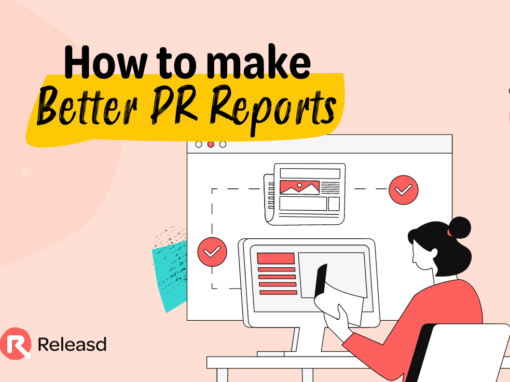
How to Make Better PR Reports (Six Actionable Tips)
Best practice for PR professionals looking to demonstrate the value of their work more effectively.
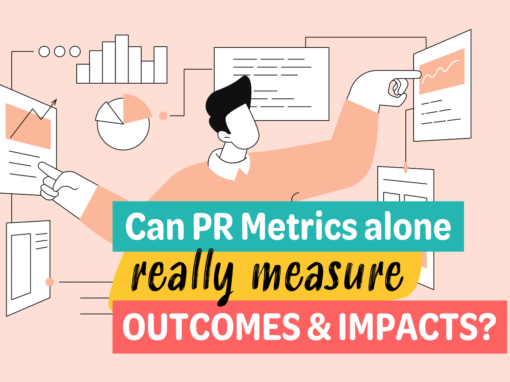
Can PR Metrics Truly Measure Outcomes & Impacts?
Richard Benson | MD, Releasd One of the most fiercely debated topics in PR surrounds the industry’s ability to prove
How to write a case study — examples, templates, and tools

It’s a marketer’s job to communicate the effectiveness of a product or service to potential and current customers to convince them to buy and keep business moving. One of the best methods for doing this is to share success stories that are relatable to prospects and customers based on their pain points, experiences, and overall needs.
That’s where case studies come in. Case studies are an essential part of a content marketing plan. These in-depth stories of customer experiences are some of the most effective at demonstrating the value of a product or service. Yet many marketers don’t use them, whether because of their regimented formats or the process of customer involvement and approval.
A case study is a powerful tool for showcasing your hard work and the success your customer achieved. But writing a great case study can be difficult if you’ve never done it before or if it’s been a while. This guide will show you how to write an effective case study and provide real-world examples and templates that will keep readers engaged and support your business.
In this article, you’ll learn:
What is a case study?
How to write a case study, case study templates, case study examples, case study tools.
A case study is the detailed story of a customer’s experience with a product or service that demonstrates their success and often includes measurable outcomes. Case studies are used in a range of fields and for various reasons, from business to academic research. They’re especially impactful in marketing as brands work to convince and convert consumers with relatable, real-world stories of actual customer experiences.
The best case studies tell the story of a customer’s success, including the steps they took, the results they achieved, and the support they received from a brand along the way. To write a great case study, you need to:
- Celebrate the customer and make them — not a product or service — the star of the story.
- Craft the story with specific audiences or target segments in mind so that the story of one customer will be viewed as relatable and actionable for another customer.
- Write copy that is easy to read and engaging so that readers will gain the insights and messages intended.
- Follow a standardized format that includes all of the essentials a potential customer would find interesting and useful.
- Support all of the claims for success made in the story with data in the forms of hard numbers and customer statements.
Case studies are a type of review but more in depth, aiming to show — rather than just tell — the positive experiences that customers have with a brand. Notably, 89% of consumers read reviews before deciding to buy, and 79% view case study content as part of their purchasing process. When it comes to B2B sales, 52% of buyers rank case studies as an important part of their evaluation process.
Telling a brand story through the experience of a tried-and-true customer matters. The story is relatable to potential new customers as they imagine themselves in the shoes of the company or individual featured in the case study. Showcasing previous customers can help new ones see themselves engaging with your brand in the ways that are most meaningful to them.
Besides sharing the perspective of another customer, case studies stand out from other content marketing forms because they are based on evidence. Whether pulling from client testimonials or data-driven results, case studies tend to have more impact on new business because the story contains information that is both objective (data) and subjective (customer experience) — and the brand doesn’t sound too self-promotional.

Case studies are unique in that there’s a fairly standardized format for telling a customer’s story. But that doesn’t mean there isn’t room for creativity. It’s all about making sure that teams are clear on the goals for the case study — along with strategies for supporting content and channels — and understanding how the story fits within the framework of the company’s overall marketing goals.
Here are the basic steps to writing a good case study.
1. Identify your goal
Start by defining exactly who your case study will be designed to help. Case studies are about specific instances where a company works with a customer to achieve a goal. Identify which customers are likely to have these goals, as well as other needs the story should cover to appeal to them.
The answer is often found in one of the buyer personas that have been constructed as part of your larger marketing strategy. This can include anything from new leads generated by the marketing team to long-term customers that are being pressed for cross-sell opportunities. In all of these cases, demonstrating value through a relatable customer success story can be part of the solution to conversion.
2. Choose your client or subject
Who you highlight matters. Case studies tie brands together that might otherwise not cross paths. A writer will want to ensure that the highlighted customer aligns with their own company’s brand identity and offerings. Look for a customer with positive name recognition who has had great success with a product or service and is willing to be an advocate.
The client should also match up with the identified target audience. Whichever company or individual is selected should be a reflection of other potential customers who can see themselves in similar circumstances, having the same problems and possible solutions.
Some of the most compelling case studies feature customers who:
- Switch from one product or service to another while naming competitors that missed the mark.
- Experience measurable results that are relatable to others in a specific industry.
- Represent well-known brands and recognizable names that are likely to compel action.
- Advocate for a product or service as a champion and are well-versed in its advantages.
Whoever or whatever customer is selected, marketers must ensure they have the permission of the company involved before getting started. Some brands have strict review and approval procedures for any official marketing or promotional materials that include their name. Acquiring those approvals in advance will prevent any miscommunication or wasted effort if there is an issue with their legal or compliance teams.
3. Conduct research and compile data
Substantiating the claims made in a case study — either by the marketing team or customers themselves — adds validity to the story. To do this, include data and feedback from the client that defines what success looks like. This can be anything from demonstrating return on investment (ROI) to a specific metric the customer was striving to improve. Case studies should prove how an outcome was achieved and show tangible results that indicate to the customer that your solution is the right one.
This step could also include customer interviews. Make sure that the people being interviewed are key stakeholders in the purchase decision or deployment and use of the product or service that is being highlighted. Content writers should work off a set list of questions prepared in advance. It can be helpful to share these with the interviewees beforehand so they have time to consider and craft their responses. One of the best interview tactics to keep in mind is to ask questions where yes and no are not natural answers. This way, your subject will provide more open-ended responses that produce more meaningful content.
4. Choose the right format
There are a number of different ways to format a case study. Depending on what you hope to achieve, one style will be better than another. However, there are some common elements to include, such as:
- An engaging headline
- A subject and customer introduction
- The unique challenge or challenges the customer faced
- The solution the customer used to solve the problem
- The results achieved
- Data and statistics to back up claims of success
- A strong call to action (CTA) to engage with the vendor
It’s also important to note that while case studies are traditionally written as stories, they don’t have to be in a written format. Some companies choose to get more creative with their case studies and produce multimedia content, depending on their audience and objectives. Case study formats can include traditional print stories, interactive web or social content, data-heavy infographics, professionally shot videos, podcasts, and more.
5. Write your case study
We’ll go into more detail later about how exactly to write a case study, including templates and examples. Generally speaking, though, there are a few things to keep in mind when writing your case study.
- Be clear and concise. Readers want to get to the point of the story quickly and easily, and they’ll be looking to see themselves reflected in the story right from the start.
- Provide a big picture. Always make sure to explain who the client is, their goals, and how they achieved success in a short introduction to engage the reader.
- Construct a clear narrative. Stick to the story from the perspective of the customer and what they needed to solve instead of just listing product features or benefits.
- Leverage graphics. Incorporating infographics, charts, and sidebars can be a more engaging and eye-catching way to share key statistics and data in readable ways.
- Offer the right amount of detail. Most case studies are one or two pages with clear sections that a reader can skim to find the information most important to them.
- Include data to support claims. Show real results — both facts and figures and customer quotes — to demonstrate credibility and prove the solution works.
6. Promote your story
Marketers have a number of options for distribution of a freshly minted case study. Many brands choose to publish case studies on their website and post them on social media. This can help support SEO and organic content strategies while also boosting company credibility and trust as visitors see that other businesses have used the product or service.
Marketers are always looking for quality content they can use for lead generation. Consider offering a case study as gated content behind a form on a landing page or as an offer in an email message. One great way to do this is to summarize the content and tease the full story available for download after the user takes an action.
Sales teams can also leverage case studies, so be sure they are aware that the assets exist once they’re published. Especially when it comes to larger B2B sales, companies often ask for examples of similar customer challenges that have been solved.
Now that you’ve learned a bit about case studies and what they should include, you may be wondering how to start creating great customer story content. Here are a couple of templates you can use to structure your case study.
Template 1 — Challenge-solution-result format
- Start with an engaging title. This should be fewer than 70 characters long for SEO best practices. One of the best ways to approach the title is to include the customer’s name and a hint at the challenge they overcame in the end.
- Create an introduction. Lead with an explanation as to who the customer is, the need they had, and the opportunity they found with a specific product or solution. Writers can also suggest the success the customer experienced with the solution they chose.
- Present the challenge. This should be several paragraphs long and explain the problem the customer faced and the issues they were trying to solve. Details should tie into the company’s products and services naturally. This section needs to be the most relatable to the reader so they can picture themselves in a similar situation.
- Share the solution. Explain which product or service offered was the ideal fit for the customer and why. Feel free to delve into their experience setting up, purchasing, and onboarding the solution.
- Explain the results. Demonstrate the impact of the solution they chose by backing up their positive experience with data. Fill in with customer quotes and tangible, measurable results that show the effect of their choice.
- Ask for action. Include a CTA at the end of the case study that invites readers to reach out for more information, try a demo, or learn more — to nurture them further in the marketing pipeline. What you ask of the reader should tie directly into the goals that were established for the case study in the first place.
Template 2 — Data-driven format
- Start with an engaging title. Be sure to include a statistic or data point in the first 70 characters. Again, it’s best to include the customer’s name as part of the title.
- Create an overview. Share the customer’s background and a short version of the challenge they faced. Present the reason a particular product or service was chosen, and feel free to include quotes from the customer about their selection process.
- Present data point 1. Isolate the first metric that the customer used to define success and explain how the product or solution helped to achieve this goal. Provide data points and quotes to substantiate the claim that success was achieved.
- Present data point 2. Isolate the second metric that the customer used to define success and explain what the product or solution did to achieve this goal. Provide data points and quotes to substantiate the claim that success was achieved.
- Present data point 3. Isolate the final metric that the customer used to define success and explain what the product or solution did to achieve this goal. Provide data points and quotes to substantiate the claim that success was achieved.
- Summarize the results. Reiterate the fact that the customer was able to achieve success thanks to a specific product or service. Include quotes and statements that reflect customer satisfaction and suggest they plan to continue using the solution.
- Ask for action. Include a CTA at the end of the case study that asks readers to reach out for more information, try a demo, or learn more — to further nurture them in the marketing pipeline. Again, remember that this is where marketers can look to convert their content into action with the customer.
While templates are helpful, seeing a case study in action can also be a great way to learn. Here are some examples of how Adobe customers have experienced success.
Juniper Networks
One example is the Adobe and Juniper Networks case study , which puts the reader in the customer’s shoes. The beginning of the story quickly orients the reader so that they know exactly who the article is about and what they were trying to achieve. Solutions are outlined in a way that shows Adobe Experience Manager is the best choice and a natural fit for the customer. Along the way, quotes from the client are incorporated to help add validity to the statements. The results in the case study are conveyed with clear evidence of scale and volume using tangible data.

The story of Lenovo’s journey with Adobe is one that spans years of planning, implementation, and rollout. The Lenovo case study does a great job of consolidating all of this into a relatable journey that other enterprise organizations can see themselves taking, despite the project size. This case study also features descriptive headers and compelling visual elements that engage the reader and strengthen the content.
Tata Consulting
When it comes to using data to show customer results, this case study does an excellent job of conveying details and numbers in an easy-to-digest manner. Bullet points at the start break up the content while also helping the reader understand exactly what the case study will be about. Tata Consulting used Adobe to deliver elevated, engaging content experiences for a large telecommunications client of its own — an objective that’s relatable for a lot of companies.
Case studies are a vital tool for any marketing team as they enable you to demonstrate the value of your company’s products and services to others. They help marketers do their job and add credibility to a brand trying to promote its solutions by using the experiences and stories of real customers.
When you’re ready to get started with a case study:
- Think about a few goals you’d like to accomplish with your content.
- Make a list of successful clients that would be strong candidates for a case study.
- Reach out to the client to get their approval and conduct an interview.
- Gather the data to present an engaging and effective customer story.
Adobe can help
There are several Adobe products that can help you craft compelling case studies. Adobe Experience Platform helps you collect data and deliver great customer experiences across every channel. Once you’ve created your case studies, Experience Platform will help you deliver the right information to the right customer at the right time for maximum impact.
To learn more, watch the Adobe Experience Platform story .
Keep in mind that the best case studies are backed by data. That’s where Adobe Real-Time Customer Data Platform and Adobe Analytics come into play. With Real-Time CDP, you can gather the data you need to build a great case study and target specific customers to deliver the content to the right audience at the perfect moment.
Watch the Real-Time CDP overview video to learn more.
Finally, Adobe Analytics turns real-time data into real-time insights. It helps your business collect and synthesize data from multiple platforms to make more informed decisions and create the best case study possible.
Request a demo to learn more about Adobe Analytics.
https://business.adobe.com/blog/perspectives/b2b-ecommerce-10-case-studies-inspire-you
https://business.adobe.com/blog/basics/business-case
https://business.adobe.com/blog/basics/what-is-real-time-analytics


What you need to know to write a client case study that counts
by John McCartney | Jun 22, 2023 | Public Relations
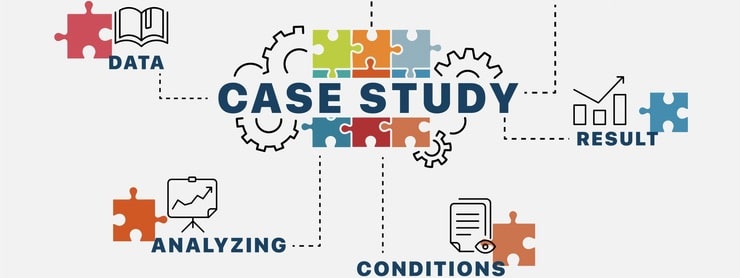
In public relations and marketing, client case studies are a powerful tool. They’re a critical way for PR agencies and brands to demonstrate their value in a specific way that readers can grasp.
Case studies are crucial in PR agencies’ efforts to showcase their expertise, build trust, educate clients and industry professionals, differentiate from competitors, inspire creativity, and foster internal learning and development. They are powerful tools for demonstrating the value and impact of PR activities and driving business growth.
I’ve spoken about the importance of storytelling in PR; at the most basic level, a case study is an extension of this idea. It’s a narrative, albeit one with a unique structure, format, and intended purpose.
In this article, I’ll provide my perspective on effective case study structure, essential elements to include, and the many doors an excellent case study can open for your agency or brand.
The structure
First, there’s no surer way to lose your audience than to make your case study too long. Your goal should be to hit on all the critical information in as few words as possible. A case study should fit onto a single PowerPoint slide. If you find yours extending to three or four slides or beyond, it’s time to get more compact.
While there is some room for variation, a case study should generally follow a three-part framework:
- Challenge : This section outlines the client’s difficulties or obstacles, setting the stage for the rest of the narrative. It also provides context and helps the reader understand why a PR campaign was necessary for the goal the client aimed to carry out. It should include some brief background on the client and explore internal and external factors contributing to the problem they sought to solve.
- Strategy : The Strategy section is the meat of the case study, providing you the space to outline the specific approaches and tactics you’ve taken to address the challenge you described in the previous section. It should accomplish two overarching goals: showcasing the thought process behind your PR campaign and demonstrating your agency’s expertise. It’s crucial to touch on the campaign’s key message and specific media relations strategies you used, including thought leadership and industry engagement. Finally, the Strategy section should briefly outline the plan for measuring the success of your campaign, setting the stage for the last area of your case study.
- Results : To cap off your case study on a concrete note, the Results section should highlight the outcomes of your campaign. If possible, it should include quantifiable metrics that paint a picture of your campaign’s reach and impact on your case study subject—for example, growth in web traffic, social media engagement numbers, or sales figures. It should also delve into earned media coverage and include details such as the number of media mentions, the reach and circulation of the publications or outlets, and the overall visibility generated.
Remember that only some cases study will follow this structure down to the letter. You may use different terminology or break one of these sections into subsections. But your case study should hit on these three components in one way or another. Like many stories that benefit from a three-act structure, case studies draw their power from following this three-part framework.
The essential elements
With our three-part framework in mind, we have the template for our case study to tell a powerful story. But this is only the beginning. For our case study to pop, we need to include a few key elements.
- Quantitative data : Hard numbers are a must-have for any case study if you can access them. With statistics and data points such as a sales uptick, growth in traffic, or a boost in online engagement, you can provide evidence of success and verifiably show the impact of your PR efforts. Quantitative data also allows for comparisons, benchmarking, and informed decision-making. It enables you to evaluate ROI and identify areas for improvement. When communicating with potential new clients, numbers act as a common language, making conveying the value and significance of your PR work easier. If you don’t have any quantitative data for your case study, include plenty of qualitative data (for instance, excerpts from media coverage or social listening analysis.)
- Creative ideas : Hard data on your PR campaign’s execution is vital, but your case study should touch on ideation, too. The Strategy section is a perfect place to do so. What creative ideas did your team create to help your client achieve their goals? How does that creativity set you apart from other agencies? Potential clients will be very interested in the answers to these questions. Providing a window into a cutting-edge campaign goes a long way toward building trust.
- Client touchpoints : Your case study should amplify the client-focused nature of your PR work and reinforce your ability to deliver exceptional results. Calling out client communications throughout your campaign is a great way to do that. By explicitly mentioning meetings, consultations, and communications, you emphasize your PR services’ personalized attention and collaborative nature. You also add credibility by illustrating hands-on involvement and a willingness to adopt tailored strategies employed throughout the engagement.
- Client testimonials : At Jmac, we’ve touched on the importance of using testimonials in your marketing strategy, and that goes for case studies, too. No matter how well you articulate the positive impact of your PR services, there’s no substitute for a firsthand account. Testimonials offer insights into the client’s experience, showcasing the direct effects of your expertise, professionalism, and results. They also humanize your PR work, allowing potential clients to relate to actual people from whom you’ve benefited. Even a one-sentence quote can make a strong case for the value of your services.
The benefits
A robust case study is a powerful tool to showcase your company’s narrative and mission. You can effectively communicate your brand story and the values that drive your organization by highlighting the strategic thinking, creative ideas, and impactful results achieved through your PR campaigns. Case studies also help attract new clients by showcasing your past work and demonstrating your value. Prospective clients can see tangible evidence of your expertise, success stories, and your positive impact on previous clients. Finally, PR case studies are crucial in pitching campaigns for PR awards. They provide needed evidence to support your entries, increasing your chances of recognition and industry accolades.
As you create your next case study, remember all the elements we’ve discussed here, but remember that there’s no one-size-fits-all approach to PR services. Finding a method that works for you and reflects what makes your services unique is critical. But once you master the art of the case study, however it may look for you, you’ll be well on your way to new clients and new horizons for your business.

RECENT ARTICLES

- Execs trust AI’s potential but challenges remain in strategy, execution, and reliability—4 in 10 don’t trust their data to generate accurate AI outputs
As the AI mission moves forward, a new survey of C-suite executives and AI leaders from cloud analytics and AI data platform provider Teradata shows while enterprise decision-makers trust the potential of AI, many lack confidence in their company’s strategy to...

- Beyond likes and shares: Measuring social media’s brand impact
In an era where likes and shares dominate the social media landscape, it's easy for businesses to become fixated on these surface-level metrics. However, beneath the facade of popularity lies a more complex reality: The true impact of social media on brand success is...

- Understanding marketing orchestration: 5 tips and strategies for using it
When you’re considering the buyer journey, you can’t expect all customers to follow the same path. This is especially true in 2024. There are more channels than ever through which customers interact with a brand. Take a second and think about all of the platforms that...

THIS MONTH'S WEBINAR
Your privacy & cookies.
Not a member yet? Learn more about joining here.
Connect with
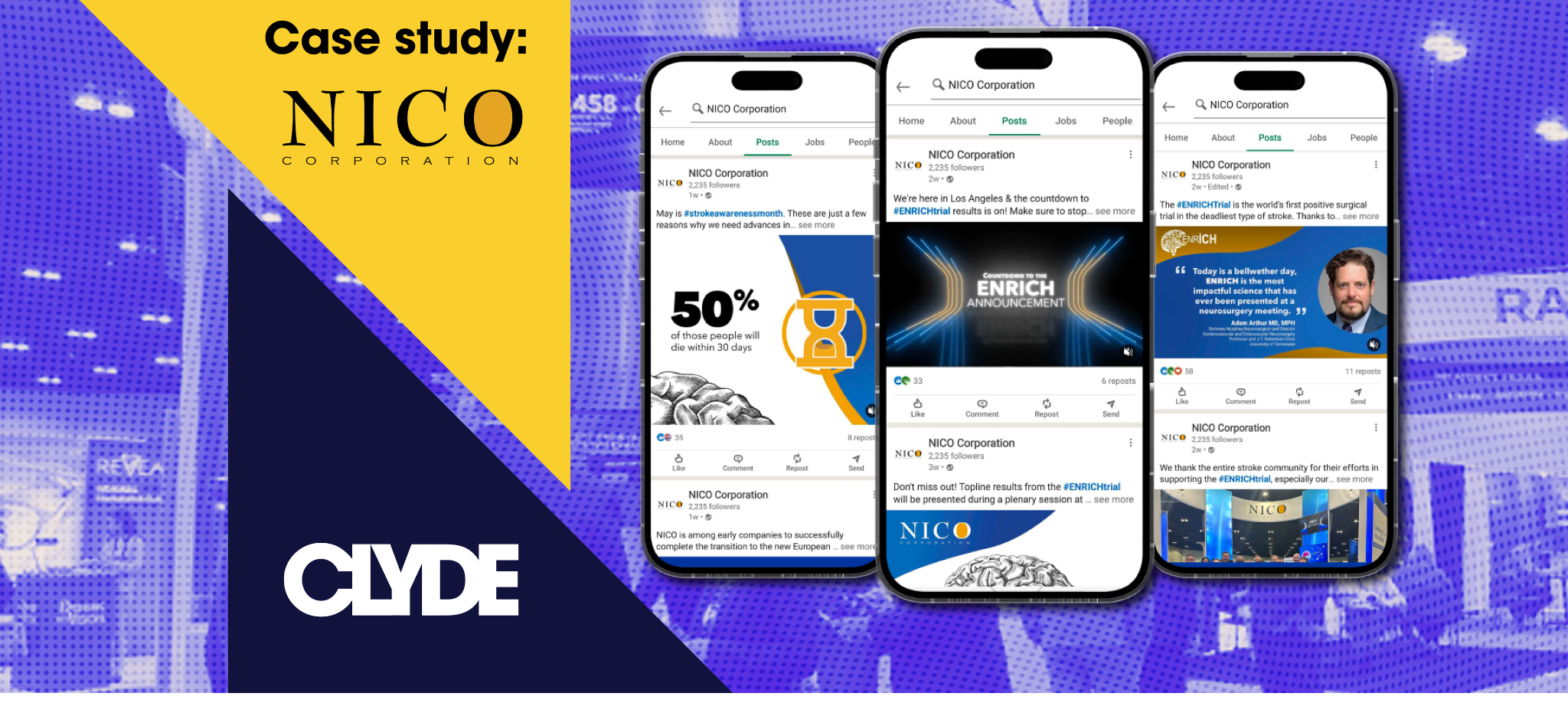
Case Studies
- ALL CASE STUDIES
- Account Based Marketing (ABM)
- Corporate Communications
- ESG Communications
- Food & Beverage
- Social Responsibility
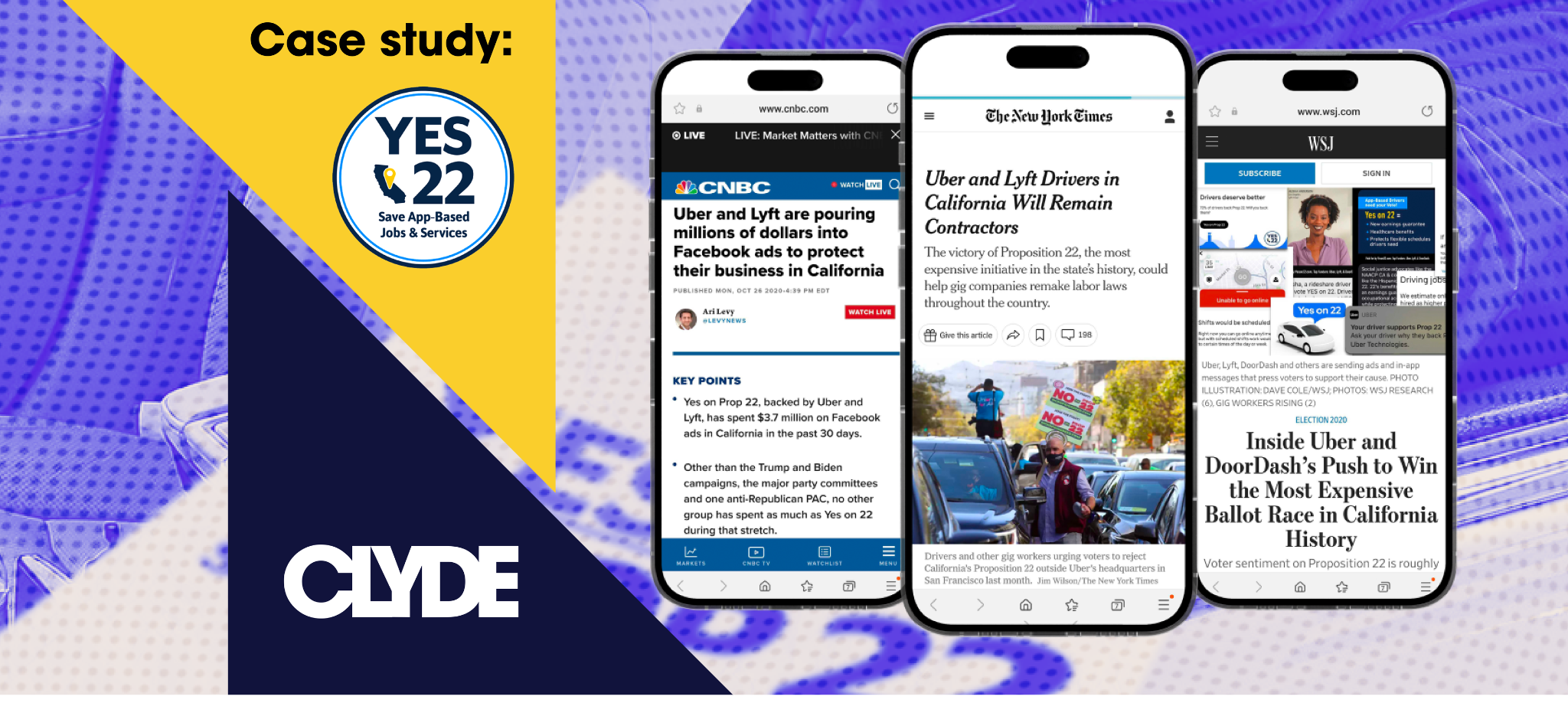
Enriching Results with NICO & CLYDE
NICO Corporation, in partnership with Emory University, was set to announce the results of their seven-year multi-site clinical trial, ENRICH, […]
A Place for Everyone with Rover & CLYDE
When alarming data showed that 20–50% of women don’t leave abusive relationships because of concern about a pet’s fate, Rover […]
Retiring the Crash Test Dummy with Altair and Tier One Partners
Digital twin technology uses data to create digital models of virtually anything in the real world to improve and speed […]
The Primetime-ification of Women’s Sports with Ally and Tier One Partners
Despite record-breaking viewership and huge opportunity for brands to spur fan engagement, women’s sports receive less than 10% of media […]
Launching Workhuman’s Human Workplace Index with SourceCode
As the world of work has rapidly evolved in recent years, SourceCode developed a data storytelling concept to gauge the […]
Establishing Homebase as the Voice of Small Businesses with SourceCode
Homebase is an all-in-one SMB team management platform that serves over 100,000 small businesses and two million hourly workers to […]

Public Relations
- Evaluating Information
- Psychographics, Demographics, & Public Opinion
- Case Studies
- News Sources
- Scholarly Sources
- Images & Copyright
- Cite Sources
- Research Process :: How-To This link opens in a new window
What is a case study?
The case study is a descriptive, qualitative research method that analyzes in great detail a person, an organization, or an event. Case studies are found in most applied areas, such as business, law, and marketing, and offer insight into practices and tactics. The case study's major advantage is the detail and analysis it provides of a specific person, organization, or event. Its major disadvantage is that it cannot be generalized to situations other than the one that was studied. Encyclopedia of Public Relations
In Public Relations, case studies:
- Identify the challenge a particular customer faces
- Describe the solution provided by the company
- Illustrate the measurable results gained from using the service
Databases to Find Case Studies & Industry Info
- WARC This link opens in a new window Warc provides intelligence solutions for students, faculty and staff in marketing, advertising and mass communications. more... less... Warc includes over 6,000 global case studies, and articles, opinion pieces and conference reports. It also contains comprehensive historic and forecast advertising expenditure data together with global media cost data.
- Business Source Complete This link opens in a new window Provides access to full-text, peer-reviewed business publications, as well as indexing and abstracts for many scholarly business journals. more... less... Business Source Complete (BSC) is the world's most comprehensive scholarly business database that provides full-text access to almost 4,000 business and scholarly journals, plus indexing and abstracts for the most important scholarly business journals dating back as far as 1886. Select journals included in this database are: Harvard Business Review, California Management Review, MIT Sloan Management Review, and Administrative Science Quarterly. Additional full-text content includes financial data, books, monographs, major reference works, book digests, conference proceedings, case studies, investment research reports, industry reports, market research reports, country reports, company profiles, SWOT analyses, faculty seminars (videos), and more. BSC is an important resource for researchers interested in all disciplines of business, including marketing, management, MIS, POM, accounting, finance, and economics. Updated monthly.
- IBISWorld This link opens in a new window IBISWorld provides access to detailed industry reports for over 700 plus United States industries. Each report includes industry structure, market characteristics, product and customer segments, cost structure, industry conditions, major players, market share, supply chain structure, and 5-year revenue forecasts.
Online Resources
- Case Studies in Strategic Communication Dedicated to the study of strategic communication through the case study form. Case studies illustrate the strategies, tactics, and execution of communication campaigns through in-depth coverage of a single situation. CSSC is a peer-reviewed publication housed at the University of Southern California’s Annenberg School for Communication & Journalism.
- Institute for Public Relations Research Letter The Institute for Public Relations is dedicated to the science beneath the art of public relations™. We focus on research that matters to the practice, providing timely insights and applied intelligence that professionals can put to immediate use.
- Arthur W. Page Society Includes case studies written by students for the Case Study Competition. Scroll to the bottom to load case studies from past competition winners.
- PR Council -- Case Studies The Council is dedicated to strengthening the recognition and role of public relations firms in corporate strategy, business performance and social education; to serve as an authoritative source of information and expert comment and to help set standards for the industry.
Related Guide
- Company & Industry by Janet Burka Last Updated May 14, 2024 1828 views this year
Video Tutorials
Introduction to the warc database.
Note: the home page design has been updated since this video was made. In order to navigate to the Case Finder, click the three lines in the top right corner of the page, open the Case Studies+, and then Case Finder will appear.
- << Previous: Psychographics, Demographics, & Public Opinion
- Next: News Sources >>
- Last Updated: May 22, 2024 8:54 AM
- URL: https://libguides.uta.edu/pr
University of Texas Arlington Libraries 702 Planetarium Place · Arlington, TX 76019 · 817-272-3000
- Internet Privacy
- Accessibility
- Problems with a guide? Contact Us.

Want to create or adapt books like this? Learn more about how Pressbooks supports open publishing practices.
Welcome to Public Relations Case Studies: Strategies & Actions. This OER textbook provides students with real-world PR case studies. The case studies explore PR dilemmas and campaigns in a variety of sectors and circumstances. The book offers learning opportunities about audience analysis, campaign planning, strategy, tactics, message development, media relations, and crisis communications for the PR practitioners of today and the future.
This book is available free of charge to any who wish it. It is licensed under a Creative Commons Attribution-NonCommercial-ShareAlike 4.0 International License.
This book was edited and compiled by Sam Schechter. Acknowledgements to contributing authors and copyright notices are included on a chapter-by-chapter basis.
Public Relations Case Studies: Strategies & Actions Copyright © by Sam Schechter is licensed under a Creative Commons Attribution-NonCommercial-ShareAlike 4.0 International License , except where otherwise noted.
Share This Book
- Public Relations Templates
PR is one of the oldest and most powerful marketing channels.
But getting your story covered isn’t easy. Especially if you don’t know any influential bloggers or reporters.
That’s why we created these PR templates. They’ll help you get press — even if you’re a beginner.
This page contains a library of public relations templates to help you get more coverage from journalists and bloggers.
Free step-by-step PR plan template to help you land media coverage. No email sign-up required.
Free press release template to help you get coverage in the media and in industry blogs.
Fill-in-the-blanks journalist pitch template to help you get press coverage. 100% free, no opt-in or signup required.
This site uses cookies to improve your experience. By viewing our content, you are accepting the use of cookies. To help us insure we adhere to various privacy regulations, please select your country/region of residence. If you do not select a country we will assume you are from the United States. View our privacy policy and terms of use.
- Advertising
- Content Marketing
- Crisis Management

Tips For Killer PR Case Studies
ImPRessions - Crenshaw Communications
APRIL 15, 2021
Every PR person knows that strong customer case studies are powerful additions to the B2B PR toolkit. A great case study can actually help move prospects down the sales funnel to the point where they’re ready to buy. Anatomy of a successful customer case study . They also work well for sales and marketing.
[Case Study] Messaging & Media Relations for an Award-Winning IPO – Livongo
MARCH 11, 2020
Download this case study to learn how Livongo: . The post [ Case Study ] Messaging & Media Relations for an Award-Winning IPO – Livongo appeared first on Onclusive. Developed a narrative that landed high-impact stories and boosted influential coverage. Complete Form To Learn More.
This site is protected by reCAPTCHA and the Google Privacy Policy and Terms of Service apply.
Trending Sources
PR for Anyone
- Business Wire
Ronn Torossian
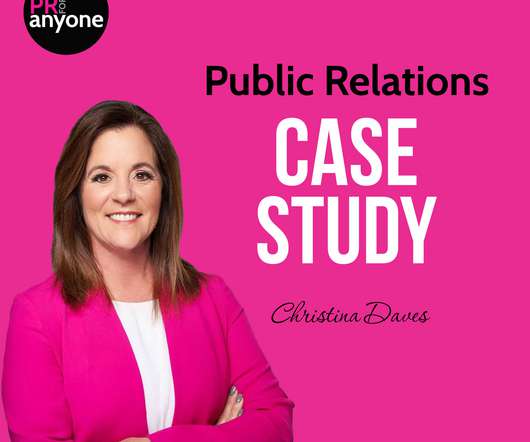
Public Relations Case Study
MAY 5, 2020
In this week’s episode, Christina Daves talks about a public relations case study during COVID-19. Part One of ‘Public Relations Case Study ’ Christina has gained billions of views from free publicity and over a hundred million in sales. She had eight hundred seventy-three million total views in one year alone.

[Case Study] Airbnb + 23andMe: Achieving Success with the Heritage Travel Campaign
JANUARY 14, 2020
Download this case study to learn how Airbnb and 23andMe used Onclusive to help them: Develop, own and use the “Heritage Travel” theme as a joint platform to drive consumer engagement. The post [ Case Study ] Airbnb + 23andMe: Achieving Success with the Heritage Travel Campaign appeared first on Onclusive.

Adapting to the Future: The Evolving Role of Crisis Management Firms in a Rapidly Changing World
Advertisement
Through interviews with industry experts and case studies , we uncover the key strategies and tactics that are driving success in this dynamic field. As the Internet continues to grow and change, the role of Online Crisis Management firms is evolving.

Benefits of Social Listening for PR Agencies (with Case Studies)
JANUARY 31, 2024
If you’re a PR agency struggling to get a seat at the table and prove the effectiveness of […] The post Benefits of Social Listening for PR Agencies (with Case Studies ) appeared first on Prowly Blog.
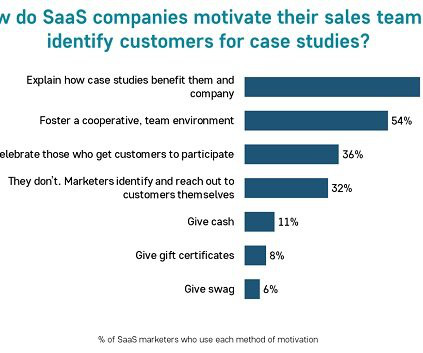
How SaaS companies are using case studies to drive results [benchmarks]
Sword and the Script
AUGUST 8, 2023
SaaS companies have an average of 38 active cases studies that are between 500-1,000 words in both HTML and PDF format; here’s how they incentives customers, sales and customer success to solicit new case studies Case studies are a pillar of B2B marketing, particularly in technology circles like software-as-a-service (SaaS).

[Case Study] How Proteus Builds Brand with Earned Media
OCTOBER 21, 2019
In this case study , learn how Proteus builds awareness and understanding using earned media amplification. The post [ Case Study ] How Proteus Builds Brand with Earned Media appeared first on Onclusive. Complete Form To Learn More.
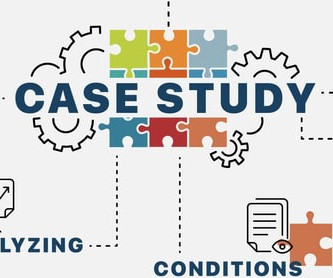
What you need to know to write a client case study that counts
Agility PR Solutions
JUNE 21, 2023
In public relations and marketing, client case studies are a powerful tool. They’re a critical way for PR agencies and brands to demonstrate their value in a specific way that readers can grasp.

REWIND Case Study: Teletubbies
Konnect Agency
MARCH 13, 2024
THE RESULTS: 300M Media Impressions 200+ Media Placements Produced over 300 social posts (developed by Konnect) Over 400 attendees at the LA launch event 100s of social posts from influencer, media, and attendees at launch event The post REWIND Case Study : Teletubbies appeared first on Konnect Agency.

Marketing & PR for Fitness Professionals: Case study
NOVEMBER 17, 2020
The post Marketing & PR for Fitness Professionals: Case study appeared first on Prowly Magazine. When in fact, all it requires is that you learn some helpful PR techniques and methods that you can easily […].

How 23andMe Uses PR Attribution™ to Drive Business Outcomes – Case Study
SEPTEMBER 3, 2019
The post How 23andMe Uses PR Attribution™ to Drive Business Outcomes – Case Study appeared first on Onclusive. COMPLETE FORM TO LEARN MORE.
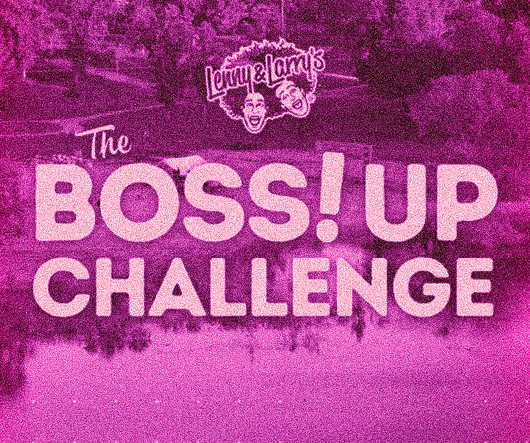
REWIND Case Study: Lenny & Larry’s
MARCH 20, 2024
Up Challenge 2022 The post REWIND Case Study : Lenny & Larry’s appeared first on Konnect Agency. During the event, camera crews followed each team through the entire course, spanning nearly three miles, capturing footage and cheering on the group. Lenny & Larry’s BOSS!

The Anatomy of a Great Case Study
Contently - Strategy
At Ogilvy, I was a member of the four-person case study writing committee. We won Most Effective Agency Office in New York relying on the tried and true case study framework: objective, strategy, results. Quantifiable objectives headlined every case study we wrote. Get permission first. Don’t do this!
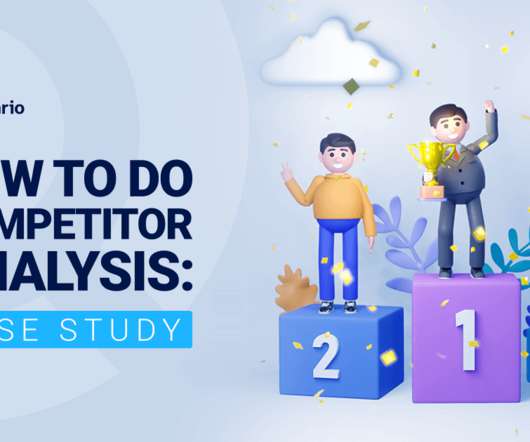
How to do competitive analysis on social media: case study
AUGUST 10, 2021
We break social media competitor analysis into 5 simple steps by comparing Apple Music, Spotify, and Google Play Music in an exciting social listening case study .

5 Tech Brand Case Studies That Will Inspire You
JANUARY 24, 2022
Here is an inside look at five influential tech success stories from our flipbook of 47 Content Marketing Case Studies That’ll Inspire You to encourage your brand to make meaningful changes in the new year. . The post 5 Tech Brand Case Studies That Will Inspire You appeared first on Contently.

Leveraging BuzzStream for Effective Digital PR – Reboot Online Case Study
JANUARY 15, 2024
In this case study , we explore how BuzzStream has helped the team of 70+ digital PR specialists working at Reboot Online earn more than 30,000 pieces of organic coverage for our clients. The post Leveraging BuzzStream for Effective Digital PR – Reboot Online Case Study appeared first on BuzzStream.

Creating a PR Campaign Case Study
SEPTEMBER 26, 2017
When you create a PR campaign case study , you need to know some things in advance to make it work as it should. The post Creating a PR Campaign Case Study appeared first on 5WPR CEO Ronn Torossian Founder's Blog. So let’s start with the basics. So let’s start with the basics. Yes, that “why” is important.
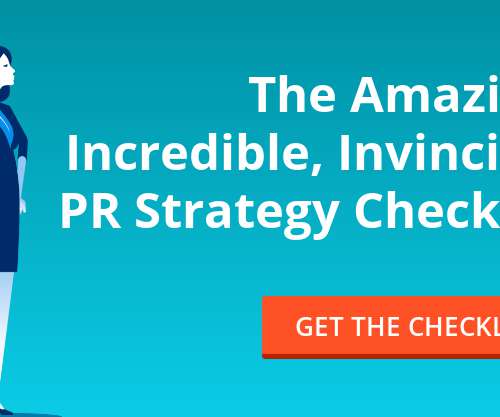
What’s the difference between a case study and a testimonial?
FEBRUARY 6, 2020
“A satisfied customer is the best business strategy of all…” Michael LeBoeuf “Show me ROI, or it’s not a case study .” I had been given some content, what the client insisted was a case study , but it did not include information […]. appeared first on Agility PR Solutions.

Case Study: Bauer
JUNE 2, 2020
CASE STUDY . The post Case Study : Bauer appeared first on Newswhip. How Bauer Media uses NewsWhip to unify content strategy across all of their brands. Ali Wilkinson, Digital Content Manager. —. Company Size. 1,000+ employees. ” . —. Raidious: building a PR newswoom. Hearst: Speed in content discovery.

Crisis case study: How to turn an employee lawsuit into a brand disaster
AUGUST 15, 2021
The post Crisis case study : How to turn an employee lawsuit into a brand disaster appeared first on Agility PR Solutions. Before the scheduled walkout, the employees shared a statement of intent, which announced the walkout and criticized the company itself for the response to the […].

Case Study Turbine Labs
CASE STUDY . The post Case Study Turbine Labs appeared first on Newswhip. How Turbine Labs uses NewsWhip to understand what the news is prior to it becoming an event. Leigh Fatzinger, CEO and Founder. —. Marketing and Advertising. Company Size. 25-50 employees. Raidious: building a PR newswoom.
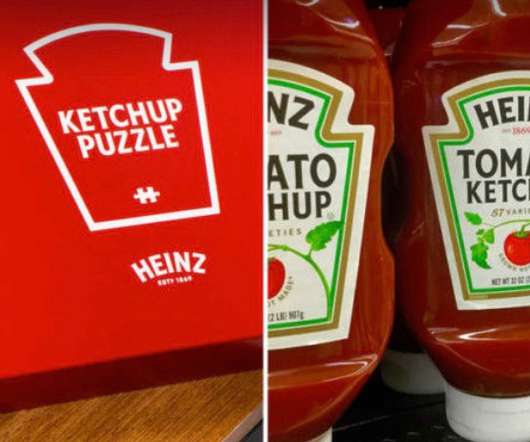
COVID case study: Heinz presents a pitch-perfect quarantine plan
MAY 18, 2020
The post COVID case study : Heinz presents a pitch-perfect quarantine plan appeared first on Agility PR Solutions. With its creation of a 570-piece puzzle colored entirely in “ketchup red,” Heinz has done exactly that. The publicity stunt is the perfect gag for consumer audiences […].

Get Famous Friday: Branding Case Study
OCTOBER 25, 2019
This week I want to give you a case study . Hi everybody. It’s Christina Daves with this week’s Get Famous Friday PR Tip. I like to incorporate these into the tips so that you can get creative and see how you could do something similar. You know, these are real-world examples of my clients who […].

Media Monitoring Case Study: How US Media Covered Depp vs. Heard Defamation Trial In 2022
JUNE 15, 2022
The post Media Monitoring Case Study : How US Media Covered Depp vs. Heard Defamation Trial In 2022 appeared first on Prowly Magazine.

Lessons from Managing a Cybersecurity Incident: A Case Study with Naren Aryal of Mascot Books
Melissa Agnes
AUGUST 8, 2019
The post Lessons from Managing a Cybersecurity Incident: A Case Study with Naren Aryal of Mascot Books appeared first on Melissa Agnes - Crisis Management Keynote Speaker. Finally, a huge ‘thank you’ to Naren Aryal for taking the time to share this story with the hopes of it resonating with and helping others.

PR Case Study: The Facebook Like Button
Doctor Spin
FEBRUARY 21, 2023
link] This post was originally published on PR Case Study : The Facebook Like Button ">Doctor Spin | The PR blog. For questions or PR support, contact me via [email protected]. ANNOTATIONS [ + ] ANNOTATIONS 1 Facebook like button. 2023, February 3). In Wikipedia.
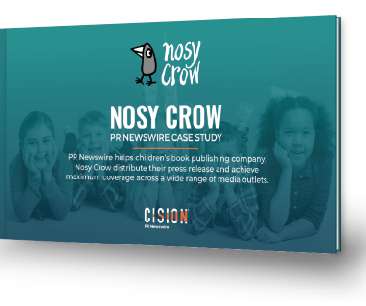
PR Newswire case study - Nosy Crow
JUNE 12, 2020
We help independent children’s publishing company, Nosy Crow distribute the news of their coronavirus book for children.

Beware the crisis case study—why it’s not a good firm evaluation tool
OCTOBER 14, 2019
Then you’ve probably seen some pretty compelling case studies —big name brands, major wins and encouraging outcomes. Case studies are a legitimate marketing tool for communication agencies for lots of reasons but they have no place in demonstrating crisis management […]. All bright, shiny and safe.

The importance of case studies
The Stalwart Blog
SEPTEMBER 23, 2016
One of the greatest resources our company’s website offers prospective clients that truly showcases our experience is our case studies . Some have argued that case studies are often more effective than brochures and traditional sales collateral. Here is a recent case study created on client Higgs Fletcher & Mack.

Is PR stress damaging your mental health? 3 case studies
OCTOBER 22, 2019
3 case studies appeared first on Agility PR Solutions. There are more than enough pressures in life and in work—having to put on a brave face, feeling like you have to change the way you act around your coworkers, or making sacrifices between work and family commitments are just some of them. Being a […].
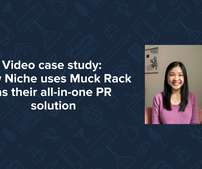
Video case study: How Niche uses Muck Rack as their all-in-one PR solution
JANUARY 14, 2022
Video case study : How Niche uses Muck Rack as their all-in-one PR solution
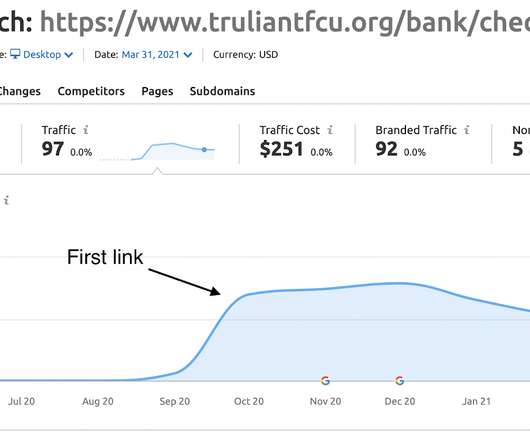
Case Study: Linking Strategies for Page Authority Growth Featuring Inseev x Truliant FCU
JULY 7, 2021
This happened to be the case for Truliant. As you read through this case study , you’ll see the unique circumstances and outcomes that make a page authority growth approach the right fit for a given website. These same pages could be your revenue-driving pages where you’ll benefit most from organic growth. The Strategy.

The best influencer marketing case study you’ll never hear about
Communications Conversations
APRIL 2, 2019
You’ve read influencer marketing case studies . But believe me when I tell you, you’ve never seen an influencer marketing case study like the one I’m about to share with you (unless, of course, you’re a loyal listener of the Power Trip Morning Show on KFAN, in which case you’ll know everything by now).
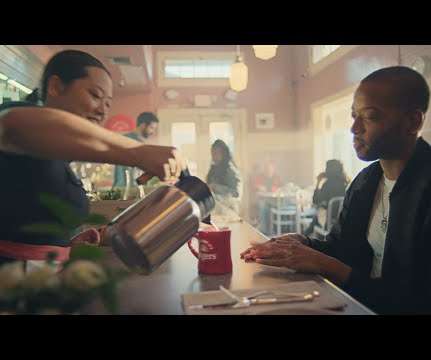
Folgers case study sums up what big ad agencies always get wrong about social
FEBRUARY 11, 2022
Thomas, we discussed a case study . The post Folgers case study sums up what big ad agencies always get wrong about social first appeared on Arik Hanson. Last week in class where I teach as an adjunct at the University of St. As an industry, we need to do better. Our clients deserve it.

A Case Study for a Case Study
HMA Public Relations
JANUARY 4, 2018
A case study is a great way to present your agency in a positive light. The post A Case Study for a Case Study appeared first on HMA Public Relations. But how can you best provide this information without overwhelming and oversharing? Click below for more].

Use Case Studies to Boost Your Marketing
David PR Group
AUGUST 14, 2019
Today, I want to suggest beefing up your use of case studies in your marketing. Here’s why: A case study offers a glimpse into how your company operates and shows a prospective customer what you do, what the results can be and how you treat your clients. As a reader, you are always attracted to a hook in a case study .

[Case Study] Lucidworks’ Clear Choice: Onclusive for PR Analytics
NOVEMBER 25, 2019
Download this case study to learn why they selected Onclusive as their PR analytics solution. The post [ Case Study ] Lucidworks’ Clear Choice: Onclusive for PR Analytics appeared first on Onclusive. Lucidworks needed a trustworthy analytics to quantify the value of PR and justify further investment.

How a Global Non-Profit Uses Soundbite Analysis to Drive Success
SEPTEMBER 29, 2021
Read this case study to learn how IFAW is using NEO to identify and leverage winning soundbites that resonate with their audience and move the needle on their campaigns.
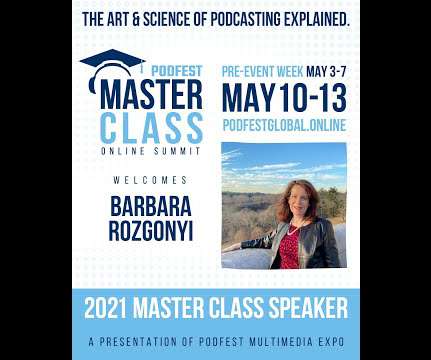
Video: Two 2021 Podcast Marketing PR Case Studies Show How to Get Results
wiredPRworks
MAY 11, 2021
In this five-minute Podcast Marketing PR Case Studies video, Barbara Rozgonyi shows you how she used the power of WIRED PR in 4D to promote an event, a topic, and a speaker. Power Up Your Podcast Marketing with WIRED PR Energy,” the case study Barbara will share, is based on results from her Podfest Global PR in February.
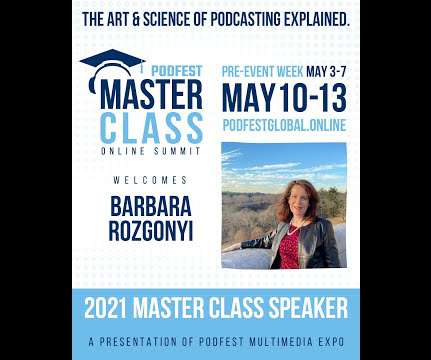
How businesses use Instagram Stories—30 case studies to learn from
AUGUST 21, 2018
The post How businesses use Instagram Stories—30 case studies to learn from appeared first on Agility PR Solutions. On average, users under 25 spend around 32 minutes a day on Instagram, while those in older age groups spend more than 24 minutes per day.
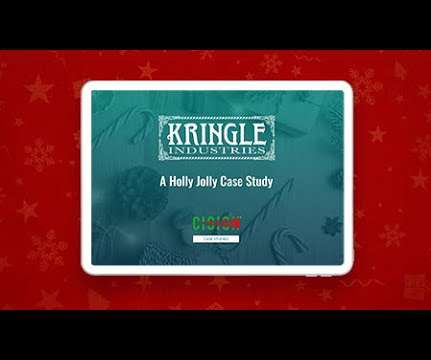
Here Comms Santa Claus: Cision's most festive case study is here!
DECEMBER 18, 2019
What to do when you're a jolly old elf, but your public sentiment isn't so jolly? Tap Cision, and save Christmas.

Katowice: A City in Poland Became the World Esports Capital [Case Study]
MARCH 25, 2019
The post Katowice: A City in Poland Became the World Esports Capital [ Case Study ] appeared first on Prowly Magazine. Today, millions of fans from around the world look favorably at the capital of Silesia. How did esports change the marketing of Katowice?
Stay Connected
Join 59,000+ Insiders by signing up for our newsletter
- Participate in Public Relations Today
- Add a Source
- Add a Resource
- 2022 Public Relations Today MVP Awards
- Tue. May 28
- Mon. May 27
- Sun. May 26
- Fri. May 24
- May 18 - May 24
- Media Relations
- Social Media
- More Topics
Input your email to sign up, or if you already have an account, log in here!
Enter your email address to reset your password. a temporary password will be e‑mailed to you., be in the know on.
Public Relations Today
Expert insights. Personalized for you.
We organize all of the trending information in your field so you don't have to. Join 59,000+ users and stay up to date on the latest articles your peers are reading.

Get the good stuff
Subscribe to the following Public Relations Today newsletters:
You must accept the Privacy Policy and Terms & Conditions to proceed.

You know about us, now we want to get to know you!
Check your mail, we've sent an email to . please verify that you have received the email..
We have resent the email to
Let's personalize your content
Use social media to find articles.
We can use your profile and the content you share to understand your interests and provide content that is just for you.
Turn this off at any time. Your social media activity always remains private.

Let's get even more personalized
Choose topics that interest you., so, what do you do.
Are you sure you want to cancel your subscriptions?
Cancel my subscriptions
Don't cancel my subscriptions
Changing Country?
Accept terms & conditions.
It looks like you are changing your country/region of residence. In order to receive our emails, you must expressly agree. You can unsubscribe at any time by clicking the unsubscribe link at the bottom of our emails.
You appear to have previously removed your acceptance of the Terms & Conditions.

We noticed that you changed your country/region of residence; congratulations! In order to make this change, you must accept the Aggregage Terms and Conditions and Privacy Policy. Once you've accepted, then you will be able to choose which emails to receive from each site .
You must choose one option
Please choose which emails to receive from each site .
- Update All Sites
- Update Each Site
Please verify your previous choices for all sites
Sites have been updated - click Submit All Changes below to save your changes.
We recognize your account from another site in our network , please click 'Send Email' below to continue with verifying your account and setting a password.
You must accept the Privacy Policy and Terms & Conditions to proceed.
This is not me

- Research Guides
- Sources by Subject
Public Relations
Find case studies.
- Get Started
- Get Background Info
- Find Company & Industry Info
- Find Demographics & Audience Analysis
- Find News Coverage
- Find Scholarly Sources
- Find Professional Organizations
- Write & Cite Help
Why Use Case Studies?

When and Why You Should Use Case Studies:
- You need to identify challenges/opportunities a particular client or organization faced
- You need descriptions of solutions provided for clients, organizations, stakeholders, or target audiences
- You need examples of measurable results gained from using the service (e.g. engagement, poll results, or revenue increases)
Remember: Case studies are frequently written with prospective clients in mind, so the agent/agency is often presented in a positive light.
- PR News Case studies are often found in the trade publication, PR News. Try searching "case study" using quotation marks.
- PR Newswire Case studies are often highlighted in this daily newswire. Try searching "case study" using quotation marks. Their main website also includes listings of recent white papers and case studies for browsing.
- Public Relations Review In-depth case studies can be found in this peer-reviewed, scholarly journal. Try searching "case study" using quotation marks.
- Arthur W. Page Society Includes original case studies written by students enrolled in an accredited school of business, communication or journalism and who are pursuing a degree that is focused on corporate communications and the practice of public relations.
- PRSA Case Studies The PRSA website includes a searchable database of Silver Anvil case studies. PRSA membership account information is needed to view the complete case studies.
- Business Source Complete This link opens in a new window Contains articles from Harvard Business Review , each issue of which usually contains a case study. Of course, there are hundreds of other publications covered by this database. Search using the subject keywords "Case studies" in combination with terms or company names of interest.
- << Previous: Get Background Info
- Next: Find Company & Industry Info >>
- Last Updated: May 18, 2024 10:16 AM
- URL: https://guides.temple.edu/public_relations
Temple University
University libraries.
See all library locations
- Library Directory
- Locations and Directions
- Frequently Called Numbers

Need help? Email us at [email protected]
BUS203: Principles of Marketing
Media and Public Relations
Visit this interactive resource. You should briefly review each of the eight primer modules and note any resources or templates you find especially useful. These resources and templates may be helpful as you undertake a public relations campaign at a future date. We will refer back to this primer elsewhere in the course for specific examples supporting subunit topics ahead. For now, it gives a useful overview of the public relations craft and some tools at its disposal. This primer was prepared to help government and business leaders in the former Soviet Union transition from a centralized system to a market system. They were expected to interact with a more free and independent media. The concept of "public and media relations" was new to many of these leaders, so this primer provides a fundamental overview of PR's basic ideas and tools.
Module 8: PR tool kit
Crisis management case study.
You are a developer who has bought a large apartment building in the middle of Moscow occupied primarily by elderly people, and you plan to turn it into a luxury hotel. You are going to throw the old folks out so you can do this. The media love this kind of story, and they will likely portray you as a villain. Reporters will ask you why you are throwing the old people out on the street.
How might you respond to a reporter's questions?
Your Suggested Strategy:

19 Successful PR Campaigns from Innovative Companies
- Megan Noorman
- December 28, 2023

Successful PR campaigns come in as many different forms as there are brands. What could be innovative and on-point for one company may be totally off-key for another.
Despite that, looking at other companies’ PR successes can still be helpful when developing a comprehensive PR campaign for your brand . So let’s look at 19 major PR successes over the years from companies across various industries and key takeaways to strengthen the impact of your next PR campaign.
1. The “Summer of Barbie” Campaign
The “Summer of Barbie” campaign, associated with the 2023 Barbie movie, created a global buzz. This vibrant campaign included painting mansions pink and setting up life-sized Barbie boxes for photo ops, leading to a surprising pink paint shortage. The campaign’s success was monumental, contributing to the movie’s staggering $2.9 billion global gross.
The Barbie campaign tapped into the nostalgia of a beloved brand while aligning it with contemporary trends. Brands can learn to blend nostalgia with modern elements to appeal to both long-time followers and new audiences.
By weaving a compelling narrative around Barbie and integrating it with real-world experiences, the campaign created a story that people wanted to be a part of. Brands should focus on crafting stories that are not only engaging but also offer opportunities for the audience to participate and contribute, creating a shared and more impactful brand journey.
2. Reinventing Financial PR with Dwolla
Dwolla, an established player in the modern payments platform sector, sought to rejuvenate its image and boost brand awareness in 2022. Zen Media’s approach was a dynamic 90-day PR blitz, focusing on forward-thinking announcements and unveiling new partnerships. This comprehensive strategy also highlighted unique case studies and proactive podcast pitches, cementing Dwolla’s position as a fintech thought leader. The outcome was impressive: over 170 media pieces and 250+ social media engagements, significantly raising Dwolla’s profile and exceeding their expectations in brand visibility.
Dwolla’s campaign also underscores the importance of innovation within industry norms. In the financial sector, where trust and reliability are paramount, Dwolla managed to inject freshness and dynamism into its brand image without losing sight of these core values. Brands in other sectors can take note of this balance between innovation and adherence to industry standards.
3. Lego Rebuild the World
Their first global PR campaign in decades, Lego’s Rebuild the World was focused on inspiring creative thinking in kids—but also adults. As part of the public relations campaign, Lego asked customers to submit pictures of their creations, aggregated onto a 3D globe on the brand’s website. Users can move and spin the globe to see what people worldwide have created.
The best part is that Rebuild the World struck the perfect balance between inspirational and playful—an exact fit for Lego’s overall brand personality.
4. Kamua’s Product Launch campaign
Our client Kamua, an AI-powered video editing platform, wanted to establish itself as an authoritative voice in the video editing industry and rapidly expand its base of dedicated users.
We worked with them to create a comprehensive, strategic public relations strategy that included bylined articles by Kamua founder and CEO Paul Robert Cary; multiple monthly mentions including in tier-one publications; and, most importantly, a Product Hunt launch campaign that would get Kamua’s name and product in front of thousands of tech-savvy users and influencers.
Kamua became one of the top three most-hunted products on Product Hunt, was featured in Product Hunt’s email newsletter , and was named Best Product of the Week by Product Hunt the week of its campaign. Just one outcome of this PR campaign? The platform gained 400 new users literally overnight.
Related read: Product Launch Marketing: Strategy, Plan, and Execute
5. Dove’s #TheSelfieTalk Campaign
A decade after the women’s skincare brand launched its Real Beauty campaign, it’s still going strong.
Why? Because they’ve involved real women (and girls) every step of the way. Their latest campaign is a commentary on how social media affects girls’ self-esteem. Their #TheSelfieTalkCampaign shows a young girl editing a photo of herself to post online. To make their point, Dove shows this process in reverse. The advertisement ends by showing the girl’s natural face without makeup or filters.
From honest conversations on beauty standards to what it means to “throw like a girl,” Dove’s public relations campaigns have evolved and adapted to the times by staying sincerely in touch with what its customers are experiencing in their daily lives.
6. BBC’s Peaky Blinders fan art campaign
Fan art is a world unto itself—but surprisingly few brands embrace this “unofficial” view, even though it’s probably the best possible source of user-generated content a brand could ever ask for.
An exception to this was the show Peaky Blinders , which issued a call to fans to create art for their new season’s imagery in 2019. Not only did this generate interest among casual viewers and those who were not yet fans, but it also strengthened the relationship between the show’s creators and the viewers who love it—a win-win.
Related read: How to Take Your User-Generated Content from Good to Great
7. Caldwell’s newsjacking campaign
Caldwell, a law firm specializing in high-growth startups and early-stage tech and life sciences, aimed to extend its brand beyond its founder’s reputation. The firm worked with Zen Media, and our innovative strategy involved a newsjacking campaign, seizing real-time opportunities for Caldwell’s attorneys to comment on global cases. This proactive approach led to numerous features in trade magazines covering tech and biotech cases, enhancing Caldwell’s visibility and establishing its lawyers as industry thought leaders.
Caldwell’s approach illustrates the effectiveness of creating a multi-dimensional brand identity . By showcasing their expertise on various platforms and media, they not only enhanced their brand visibility but also added depth to their brand’s persona. Brands should strive to create a diverse yet cohesive image that reflects their multiple strengths and areas of expertise.
8. The Eras Tour — More than just a concert
Can we call a concert tour a campaign? Why not! Taylor Swift took over the world in 2023 with her Eras Tour. She not only blasted through global attendance and revenue records for a tour and had a direct impact on local economies where she performed (and released multiple albums and a film), but she also created a widespread culture that consumed the market.
The Eras Tour exemplifies the power of a holistic marketing approach. By integrating various elements—music, visual arts, storytelling—into a cohesive campaign, Swift managed to create a brand experience that was both immersive and memorable. Brands can learn to integrate different marketing elements to create a more comprehensive and engaging campaign.
Another critical aspect of the Eras Tour’s success was Swift’s strong fan base. Brands should focus on building and nurturing a loyal community around their products or services—it can be a powerful tool in amplifying the impact of campaigns.
9. State Street Global Advisors Fearless Girl
The Fearless Girl statue that the Wall Street firm State Street Global Advisors firm placed to face down the famous Wall Street bull became a symbol of the financial sector’s lack of gender diversity, and the women who have been at the forefront of trying to change that.
But in addition to its symbolic importance, it’s also a carefully crafted advertisement—one for the firm’s exchange-traded Gender Diversity Index SHE fund.
The firm has faced some criticism over the years since putting up the statue, as it hasn’t always been clear whether State Street Global Advisors is making gender diversity a true priority.
And this brings up another important point when it comes to creating successful PR campaigns: Your brand needs to put its money where its mouth is. If you say diversity, or sustainability, or another issue is important to you, make sure you’re backing that up with real action.
Related read: Negative Public Perceptions and Other PR Problems: How To Change The Narrative
10. Calian IT & Cyber Solutions—Blending brands for a bigger impact
Following its acquisition of Computex, Calian IT & Cyber Solutions faced the challenge of merging brand identities and penetrating the U.S. market. They partnered with us at Zen Media, and we created a strategic PR roadmap, including curated proactive pitching topics to position two of Calian IT & Cyber Solutions’ senior executives as thought leaders in their areas of expertise.
Zen would also help secure the executives Forbes Technology Council memberships and launch a regular cadence of published bylines. This robust campaign led to significant media coverage and awards, with Calian’s IT & Cyber Solutions division reporting double-digit revenue growth, largely credited to their expanded U.S. presence.
In merging two brands, it’s crucial to balance innovation with the preservation of core values and strengths that define each brand. This balance helps in maintaining loyalty among existing customers while attracting new ones.
11. New Cosmos USA’s community-first approach
New Cosmos USA, committed to preventing natural gas explosions with their DeNova Detect alarm, took a unique community-centric PR approach. In response to a gas explosion in West Reading, Pennsylvania, they collaborated with Zen Media for a rapid community support and media outreach strategy. This involved donations, local PSA publications, and educational materials on gas safety.
The campaign, replicated in other locations, not only bolstered community safety but also positioned DeNova Detect as a leader in natural gas safety, leading to increased sales in those areas. By positioning the DeNova Detect alarm as a solution to a community issue, New Cosmos USA effectively aligned their product with community welfare, enhancing the product’s value proposition. Brands should evaluate the success of their campaigns not just in terms of sales but also by their impact on community welfare and social awareness.
12. Gender Pay Gap Bot Fights For Fair Wages
As we’ve stated, many companies like to raise awareness of social issues and fight for change. The Gender Pay Gap Bot is an automated Twitter account that advocates for women’s rights to equal pay—and on International Women’s Day, the bot ran a PR campaign to hold companies accountable.
Their slogan: “Stop posting platitudes. Start fixing the problem.”
As companies in various industries filled users’ feeds with empowering messages, the Gender Pay Gap Bot responded with data revealing the inequities in compensation between their male and female employees. This PR strategy sheds light on these issues through transparency and neutral messaging. Today, the Twitter account has over 240,000 followers.
13. McDonald’s ‘We Hire People’ Campaign
Companies that emphasize the importance of diversity, equity, and inclusion (DEI) initiatives are paving the way for a kinder, more inclusive world. Promoting these brand values through public relations strategies is a great way to show your commitment to welcoming all of your employees and customers.
McDonald’s ‘We Hire People” Campaign does just this. The fast-food chain introduces viewers to many individuals with various cultural backgrounds, passions, and ages. The advertisement shows that McDonald’s doors are open to everyone. These messages are essential in 2024.
14. Nike’s ‘Just Do It’ Campaign
This campaign has been one of the most successful PR campaigns of all time. The tagline “Just Do It” is simple yet powerful and has become synonymous with Nike’s brand identity. The campaign’s success is due to its inspirational message that encourages consumers to push themselves beyond their limits and achieve their goals. Nike has used the campaign to showcase its products as tools that help people achieve their athletic potential. The “ Just Do It” campaign has also featured famous athletes, such as Michael Jordan and Serena Williams, who embody Nike’s brand values of determination, perseverance, and excellence.
15. Google’s Year in Search
Google’s “Year in Search” campaign is an annual PR campaign that showcases the top trending searches of the year. The campaign has been successful because it taps into people’s emotional connections to current events and showcases Google’s ability to capture the pulse of the world through search data. The campaign is also highly shareable and creates a sense of community around the shared experience of looking back at the year’s top moments. The campaign reinforces Google’s brand identity as a company that is at the forefront of technology and innovation.
16. Red Bull’s ‘Stratos’ Campaign
In 2012, Red Bull sponsored Felix Baumgartner’s record-breaking jump from the edge of space called the “ Red Bull Stratos. ” The campaign was a massive success, generating over 52 million views on YouTube and millions of dollars in earned media coverage. The campaign was successful because it showcased Red Bull’s brand values of extreme sports and adventure while also breaking a world record. The campaign was a testament to the power of experiential marketing and how brands can leverage events to create memorable and impactful campaigns.
17. Chipotle’s ‘Food with ‘Integrity’ campaign
Chipotle’s “ Food with Integrity” campaign was an innovative marketing campaign that aimed to differentiate the company from other fast-food chains by highlighting its commitment to sourcing sustainable and ethically produced ingredients for its menu. The campaign featured a series of advertisements that showcased Chipotle’s use of fresh, locally sourced, and sustainably-raised ingredients and its efforts to reduce its carbon footprint.
What made the campaign innovative was that it was not just a marketing gimmick; Chipotle really did change its sourcing practices to live up to the promises it made in the ads. The company worked directly with farmers and producers to develop sustainable farming practices, and it paid premium prices to ensure that the farmers were able to make a living wage. The success of the campaign was due to its resonance with consumers who valued healthier, more sustainable food options and appreciated Chipotle’s mission as much as its food.
18. Patagonia Says ‘Don’t Buy This Jacket’
Patagonia’s “ Don’t Buy This Jacket” campaign was an innovative marketing campaign that aimed to encourage customers to buy less and reduce their environmental impact. The campaign was launched in 2011 and featured a full-page ad in The New York Times that showed one of Patagonia’s best-selling jackets with the headline “Don’t Buy This Jacket.” The ad went on to explain the environmental impact of the jacket’s production and encouraged customers to think twice before making a purchase.
What made the campaign innovative was that it went against the traditional marketing strategy of encouraging customers to buy more. Instead, Patagonia wanted to use its platform to raise awareness about the environmental impact of consumerism and to encourage customers to make more conscious choices. The campaign also reflected Patagonia’s long-standing commitment to sustainability and its belief that the company had a responsibility to minimize its environmental impact. The campaign was a success and helped to solidify Patagonia’s reputation as a leader in sustainability and environmental activism.
19. Airbnb’s ‘Belong Anywhere’ Campaign
This PR campaign was an innovative campaign that aimed to position the company as a global community that offered unique and authentic travel experiences. The campaign focused on Airbnb’s ability to connect people from different cultures and backgrounds, highlighting the role of welcoming and knowledgeable local hosts. The campaign was successful because it tapped into the growing trend of experiential travel and emphasized the community aspect of travel. It helped establish Airbnb as a disruptor in the travel industry and drove significant growth for the company.
Creating an innovative, successful PR campaign requires a team of experts who know your brand inside and out. If you’re looking for help making your next PR campaign stand out, get in touch with Zen !
- Public Relations
- business marketing strategies , Online Marketing , pr campaign , public relations

The 5-Day MBA in Modern Day PR
- Wondering how to connect PR to bottom-line sales and ROI?
- Tired of asking, "How can I measure PR efforts?"
- Not sure of the role PR even plays in today’s world?

Don’t miss!
Expert-level insights direct from our ceo’s desk..
- Reach new audiences.
- Retain clients.
- Boost overall sales.
Explore the latest in B2B PR and marketing

- May 16, 2024
- Content Strategy , Misc , Public Relations
Building Blocks for Success: B2B Brand Management Essentials

- May 14, 2024
- Public Relations , Social Media Marketing
The Case for Crisis Communication as a Tool for Reputation Management

- May 13, 2024
- Content Strategy , Public Relations
How To Make Your Inc. 5000 Buzz Last in 2024
Let’s talk., our clients are smart, thoughtful, & forward-thinking., sound like you get in touch..
Minority and Women-Owned | DBE, MBE & SBE Certified | Creative + Communications + Conversions
- Technical Support
- Find My Rep
You are here
Cases in Public Relations Strategy
- Burton St. John III - University of Colorado Boulder, USA
- Diana Knott Martinelli - West Virginia University, USA
- Robert S. Pritchard - University of Oklahoma, USA, Ball State University, USA
- Cylor Spaulding - Cal State University, Fullerton, USA
- Description
Cases in Public Relations Strategy draws on original, real-world case studies to provide students with a strategic approach to meeting the needs of a client before, during, and beyond a campaign. Using the RACE (Research, Action Planning, Communication, and Evaluation) model, students explore successful contemporary campaigns and evaluate best practices in all major areas of public relations activity. This practical, client-oriented text shows students how to systematically evaluate and adapt to the needs of a particular client—whether big or small, global or local, for-profit or nonprofit—in order to launch the most effective campaign. Each case includes a brief introduction focused on fundamentals and core competencies, and all cases have been carefully selected to present a wide range of client types. In addition to the lessons from professionals in the case studies, a section on PR consulting and an appendix on advancing your PR career give students the knowledge and skills they need for success in the field.
Give your students the SAGE edge!
SAGE edge offers a robust online environment featuring an impressive array of free tools and resources for review, study, and further exploration, keeping both instructors and students on the cutting edge of teaching and learning. Learn more at edge.sagepub.com/stjohn .
See what’s new to this edition by selecting the Features tab on this page. Should you need additional information or have questions regarding the HEOA information provided for this title, including what is new to this edition, please email [email protected] . Please include your name, contact information, and the name of the title for which you would like more information. For information on the HEOA, please go to http://ed.gov/policy/highered/leg/hea08/index.html .
For assistance with your order: Please email us at [email protected] or connect with your SAGE representative.
SAGE 2455 Teller Road Thousand Oaks, CA 91320 www.sagepub.com
Supplements
- Test bank provides a diverse range of pre-written options as well as the opportunity to edit any question and/or insert your own personalized questions to effectively assess students' progress and understanding.
- Editable, chapter-specific PowerPoint® slides offer complete flexibility for creating a multimedia presentation for your course.
- Sample course syllabi for semester and quarter courses provide suggested models for structuring your courses.
- Multimedia content includes third-party video, audio, and web links that appeal to diverse learners.
- Chapter and Case Summaries summarize key concepts and cases by chapter to help you prepare for lectures and class discussions.
- Case Study Resources includes a resource guide for instructors teaching the case course the first time, links to award-winning cases, chapter activities, and sample long-term projects students can undertake to facilitate a deeper exploration of public relations.
- Chapter and Case summaries reinforce the most important material
- Mobile-friendly practice quizzes allow for independent assessment by students of their mastery of course material.
- 30 original, contemporary case studies drawn from the real world Introduce key concepts and skills in Public Relations.
- A focus on strategic areas within the profession (heath communication, issue advocacy, etc.), rather than skill-sets, demonstrates how various strategies and tactics can be adapted to meet the needs of various clients.
- An emphasis on strategy and strategic thinking , rather than individual tactics, prepares students for the realities of a PR career.
- A unique client-oriented focus shows that Public Relations is not “one size fits all.” The selection of cases from a wide range of clients in core PR areas demonstrates the need for adjusting PR strategy for each client type.
- RACE Pit Stop sections include discussion items, trend line information, and comments from professional observers that show students to integrate key findings from the case studies into their own PR work.
- SAGE edge provides students helpful tools, including eFlashcards, practice quizzes, and more, in one easy-to-use online environment.
Sample Materials & Chapters
Chapter 1. Branding
Chapter 2. Community Relations
For instructors
Select a purchasing option, related products.

This title is also available on SAGE Knowledge , the ultimate social sciences online library. If your library doesn’t have access, ask your librarian to start a trial .
How To Write a Compelling Public Relations Proposal

A public relations proposal is a type of proposal that outlines the strategies, activities, and objectives of a public relations campaign. This document is crucial in the sales process , as it enables PR agencies and clients to set clear goals, expectations, and budgets for a successful PR campaign.
The main purpose of a public relations proposal is to persuade potential clients or stakeholders to invest in a specific PR campaign or project. To help close the sales deal , the proposal should clearly outline how the proposed strategy or campaign will benefit the business. It needs to outline all the elements involved in bringing the campaign to a successful resolution.
You can see an example of our professionally designed PR proposal template below:
Public Relations Proposal Template
Win clients with a captivating and well-organized PR plan – create a strategic, customized, and effective public relations proposal quickly.

Eight steps to write a public relations proposal: key elements to include
Writing a PR proposal should follow one main goal: to convince potential clients that the proposed PR campaign will meet their objectives and deliver results. In order to do that successfully, there are some steps you will need to take and elements that must be included when you write your sales proposal . These are:
1. Create a great executive summary
The first section of your proposal should be a concise summary outlining the key elements of your campaign suggestion. This element will "hook" your prospect, so be sure to include a visually attractive cover and a compelling look at your plan.
This summary should grab the attention of potential clients and briefly explain why they can benefit from your services. Keep it short and impactful, highlighting key points such as:
Target audience
- Proposed strategies
Expected results
Remember also to include a quick overview of your agency. This can be a pre-written introduction showcasing your team and media contacts and a high-level overview of previous successes.
2. Offer a quick situational analysis
A situational analysis is an in-depth examination of a company's current position, taking into account internal and external factors that may impact the success of a PR campaign. This section should assess the customer's strengths, weaknesses, opportunities, and threats to provide context for your proposed strategies.
Some questions to consider include:
- What are the company's unique selling points?
- What are their current communication channels and messaging?
- What are the potential challenges they may face during a PR campaign?
3. Include market research results
Market share lends your strategy credibility and helps show you understand your client's industry and competitors. Showcasing some market research, statistics, or industry trends can also help convince potential clients of the validity of your proposed strategies.
4. Make an audience & awareness review
Show your customer you understand who the campaign is targeting and how it will promote brand awareness. Your audience review should highlight demographics, behaviors, interests, and pain points to prove that you comprehensively understand their target market.
5. Explain strengths & weaknesses
Once you understand your client's needs and target audience, the next step is to propose various strategies that could help achieve their objectives. This section should outline the pros and cons of each strategy, explaining how they align with the customer's goals and budget.
6. Include the goals and objectives
Explain what your campaign goals and objectives are. The key difference between a goal and an objective is that a goal is an overarching aim, while objectives are specific, measurable steps to achieve the goal. Clearly define both in this section and explain how they will be met.
7. Showcase the strategic plan
This is where you explain the actual plan, from A to Z: what you plan to do to help the company reach its objectives. This section should include the following elements:
The target audience is the specific group of individuals that your PR campaign seeks to reach, influence, and engage with. Understanding your target audience is vital as it allows for more strategic and effective communication, ensuring that your PR efforts resonate with those most likely to react positively and take action, thereby improving the overall success of your campaign.
Target media
Target media refers to the specific channels through which you plan to disseminate your PR messages, such as newspapers, magazines, TV channels, blogs, podcasts, or social media platforms. Selecting the right media outlets is critical as it affects the reach and impact of your PR campaign, ensuring your messages are delivered to your target audience most effectively.
Key message
What is the main message you want to share with your audience? What should they think or do once they see or interact with your campaign? Explain this as briefly as you can, so you can convince your prospect that your campaign idea is worth their attention (and budget).
Your tactics are the specific actions you will take to spread your key message to your target audience through your chosen media outlets. This could involve creating press releases, organizing events, leveraging social media influencers, or creating compelling content that aligns with the interests and needs of your target audience.
Provide an estimated timeline for the PR campaign, outlining when each tactic will be implemented. This allows clients to understand the schedule and flow of the campaign activities.
A detailed budget gives a clear picture of the costs involved in the campaign, including fees for agency work, media buying, event organization, content creation, and any other expenses. Providing a transparent, itemized budget helps build trust with the client.
Measure of success
Lastly, but crucially, define how you will measure the success of the campaign. This could be through media impressions, website traffic, lead generation , sales, or other measurable outcomes. This shows the client how you will track and prove the effectiveness of your PR efforts.
Campaign tactics
This is where you list out and explain each tactic in detail. For example, if your proposed tactic is to organize an event, describe the intended purpose of the event, potential venues, target audience, and expected outcomes. If your tactic is to create a media relations campaign, outline how you will pitch stories and secure media coverage.
Campaign timeline
Draw a timeline that shows the various stages of the campaign and when each tactic will be executed. This helps clients visualize the scope and duration of your proposed campaign -- and it helps you show them you have more than just a high-level idea but an actionable, step-by-step plan on what to do at each stage of the campaign.
In this section, explain what results you expect to achieve with your campaign in measurable terms. This could include an increase in media coverage or website traffic, a specific number of leads or sales generated , or improved brand awareness and reputation within the target audience. Providing expected results helps set realistic expectations for your client and shows them how their investment in the PR campaign will pay off.
Project scope
The project scope section is where you outline the scope of work that you will cover in your PR campaign. This could include the number of press releases, events, media coverage opportunities, or social media posts that you plan to produce and execute. Providing a detailed project scope helps clients understand what they can expect from your services and ensures that both parties are on the same page regarding the deliverables.
Last but not least, include a quick overview of how you will evaluate your campaign's success once it has concluded. This could include a post-campaign review of media coverage and engagement, a comparison of expected versus actual results, and any key learnings or insights gained from the campaign. Clients appreciate when you provide them with data-backed evaluations as it demonstrates your commitment to delivering tangible results.
8. Detail your pricing
Your sales proposal should also include a clear, detailed pricing table that breaks down the costs of each service and tactic offered. This helps clients understand how their budget will be allocated and allows for transparency in the pricing process . Be sure to itemize each cost, including any additional fees or expenses that may arise during the campaign. This will help avoid any confusion or surprises later on.
Remember that everything leading up to the pricing or budget outline should underline the value your customer is getting from your services. Show them how you will help them achieve their objectives and what makes your PR services stand out.
Make your PR proposal stand out with these three tips
The best sales proposals go the extra mile -- they're creative, personalized, and leave a lasting impression. Here are three tips to make your PR proposal stand out from the rest:
1. Start with a discovery meeting
This might sound basic, but it can make a difference in how you build a relationship with your prospect . You want to understand who your customer is, what they do, and why they need you. This is at the core of most effective sales methodologies . More importantly, you want to understand their audience and how they interact with them. A discovery meeting is essential in understanding all these elements to create a proposal addressing their needs.
Some of the questions to ask at this stage include:
- What is the company's mission and values?
- Who are their target audience, and what channels do they use to communicate with them?
- What public relations activities have they done, and what were the results?
2. Create a professional-looking design
Theoretically, you can create a simple PR proposal in a Google Sheets spreadsheet or a Doc, download it as a PDF, and call it a day.
But that wouldn't serve you very well.
You need to look professional -- because that's exactly how you will make your customer look too. You need to show you know what you're doing and that you're worth every penny. So invest in a professional design that includes your logo, some on-brand elements, and high-quality images or graphics.
3. Incorporate social proof
Part of why people buy things is because other people buy them. When you include social proof (customer quotes, testimonials, case studies ) in your sales proposal, you show that other people trust and have seen success with your services.
Social proof can help build credibility and trust with your prospect and give them the reassurance they need to sign on as a client. So don't be shy about showcasing your past successes and happy clients - it could make all the difference in closing the deal .
Improve sales efficiency with content management
Align sales and marketing functions with a single destination for sales content
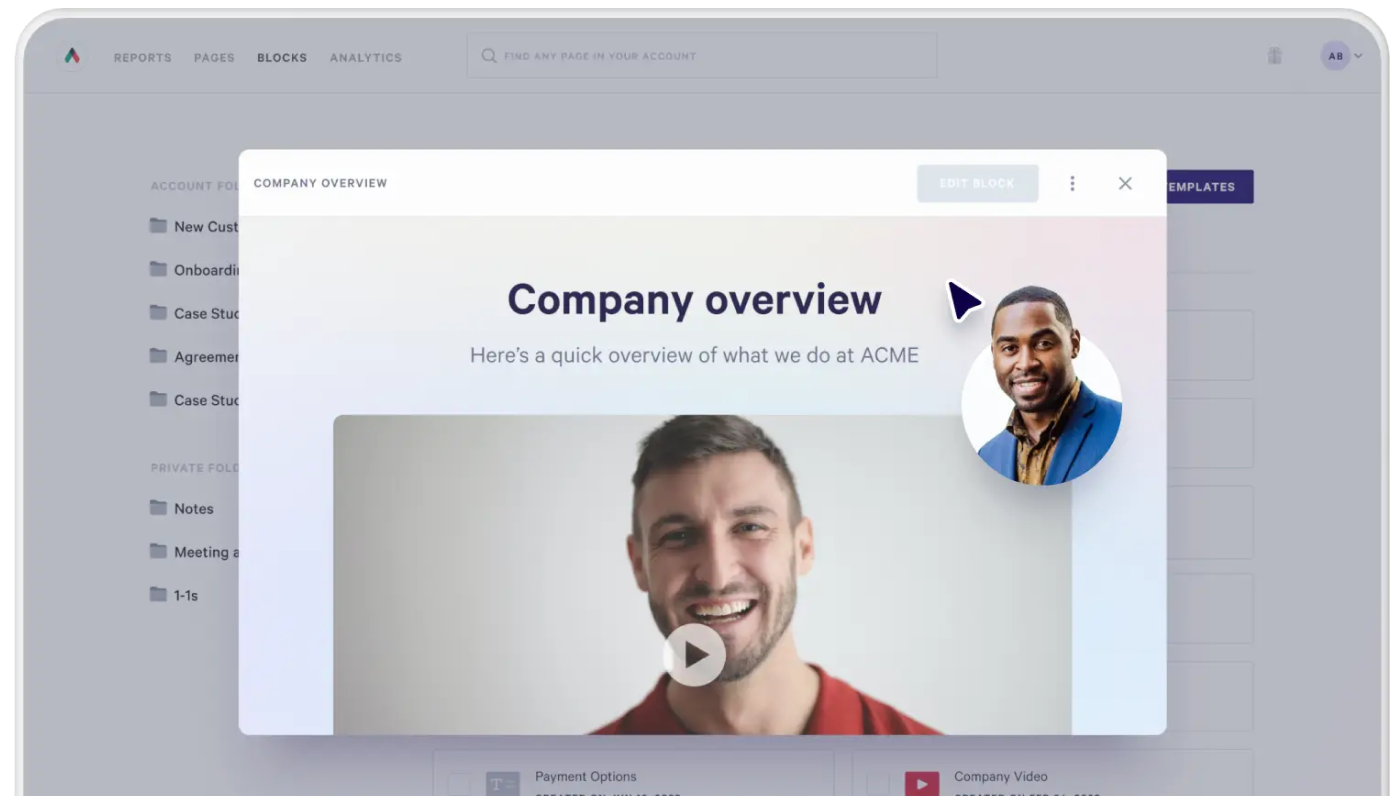
Example of public relations proposal template
Want to speed up your sales productivity , ensure consistency, and make sure you never miss the mark on what your proposal needs to include?
Get a public relations proposal template . For example, the Qwilr PR proposal template comes with everything you need:
- A clean, professional-looking design
- Infinite customization options
- All the proposal elements you need, including (but not limited to:)
- Executive summary
- Target audience and key messages
- Strategic Plan
- Market research showcase
- Project breakdown
Essentially, all you have to do is add your own branding and client specifics to the proposal template . It also comes with a built-in eSignature , allowing your prospect to sign off on your proposal directly in the document - no more back-and-forth emails or printing, signing, and scanning documents. Just good, old-fashioned sales conversations (but with a modern, efficiency-driven twist).
Alternatively, spin up a professionally designed proposal in minutes using our AI proposal generator .
What’s the best format for a public relations proposal?
The best format for a public relations proposal ticks the following boxes:
- It sets the stage (with a smart executive summary)
- It explains the proposed campaign (including market research, strategy, and timeline)
- It outlines the costs of running said campaign (emphasizing the value it provides.)
Final thoughts
People frequently perceive PR as intangible and hard to measure, which makes it difficult to sell, particularly in times of economic uncertainty.
It doesn't have to be this way, though. A good, well-written, cohesive, and comprehensive public relations sales proposal can make all the difference in convincing your prospect to invest in your services. It can help you outline not just what you plan to do, but the actual value your customer's getting out of it, too.
Remember your proposal should be about them, not you -- highlight how your services will help them achieve their goals. Take your time to understand your prospect's business, audience, and challenges to write targeted, personalized proposals that stand out and close the deal.
And make your processes simpler by using a template. It can save you time, make your proposals look more enticing, make it easy for clients to share them with their stakeholders, and ultimately help you land more clients.
About the author

Marissa Taffer | Founder & President of M. Taffer Consulting
Marissa Taffer is the Founder & President of M. Taffer Consulting. She brings over 15 years of sales and marketing experience across various industries to a broad range of clients.
Related articles
- All articles
- Sales management
- Sales techniques
- Sales enablement
- Customer success
- Product updates

- PR Outreach
- Productivity
- PR Industry
- Reputation Management
- PR Software
Reach journalists more effectively
- Brand Journal
- Audience Pitch
- Press Release Creator
- Media Discovery
PR Crisis Management Guide (w/ Strategies and Examples)

- Introduction
Nothing is certain, except for a PR crisis . At a time when crises arise on all sides – from your company actions to TikTok challenges – formulating crisis management strategies in public relations is a must.
Until you can prevent all public relations crises, you can – and should – prepare for them in advance.
For a robust solution in PR crisis management and beyond, explore Prowly’s 7-day trial. Monitor your brand’s mentions, evaluate sentiment, and generate PR reports with just a few clicks . Gain the power to safeguard your brand’s reputation, stay updated on competitors’ activities, and proactively identify potential crisis triggers.
What is PR Crisis Management?
PR crisis management is an organizational strategy to manage and mitigate unexpected events that pose a threat to the reputation or survival of a company .
This approach focuses on thorough planning to promptly and efficiently respond to any crisis that could impact the company’s image or stakeholder relationships.
Ultimately, the effectiveness of PR crisis management is gauged by how well a crisis is handled, how swiftly the company recovers, and how the crisis impacts long-term trust and relationships with stakeholders.
Usually, brands plan ahead with PR crisis management strategies, which define:
- what potentially harmful situations look like
- what steps should be taken (and by whom)
- how to handle the media during a crisis
- and what to do after the crisis has been managed
How to spot a PR crisis in time?
The first rule of crisis management in PR: the sooner you know, the better.
Learn our methods of spotting upcoming trouble.
Rule #1. Monitor mentions around your brand
If you haven’t already started media monitoring , it’s high time you did. Why?
You can learn what journalists and social media users say about your brand or the topics you care about in real-time. It’s the single biggest reason to use media monitoring . With this intel, you can react appropriately and promptly, which is crucial in PR crisis prevention.
The immediate nature of alerts helps you find out about potential threats and tackle them before the media, your stakeholders, or your client base becomes concerned.
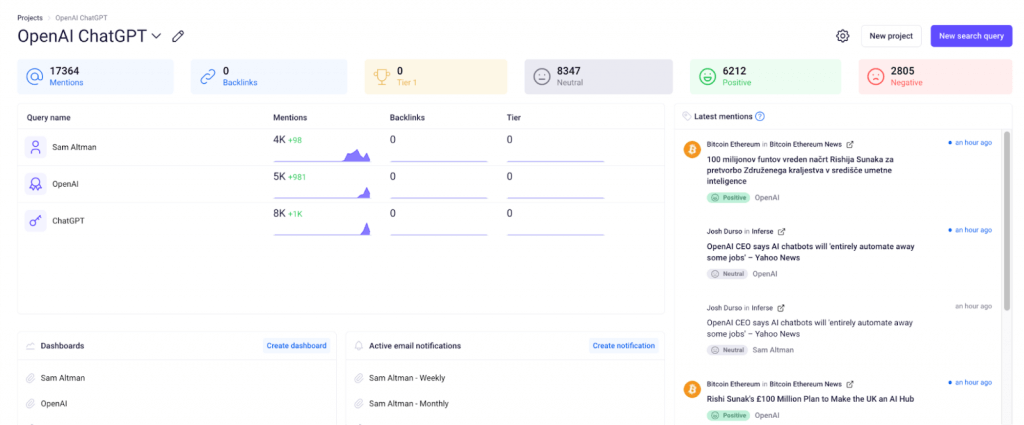
Of course, media monitoring proves insightful all the time. When the situation is stable, you can use it to measure your PR results , like earned media . It also shows you potential new initiatives or cooperation opportunities.
Media monitoring gives you an understanding of what makes up the usual level of noise. With these numbers in hand, you can easily assess what changes should concern you.
→ Interested in diving into the details? Read our Media Mentions Guide .
Rule #2. Use media monitoring tools to prevent a PR crisis
You don’t have to scroll through the internet in search of media mentions to analyze. Tools like Media Monitoring do it for you, and even add more information, like sentiment , estimated reach, and context.
You can get real-time notifications about the content. Even before it appears on Google search.
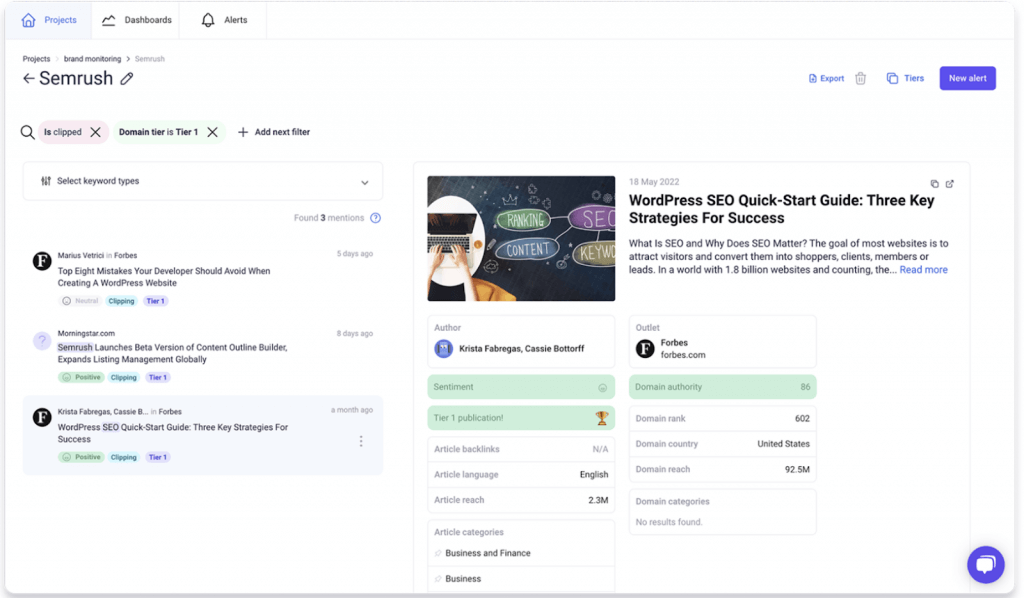
Prowly AI helps identify the context of each press hit so you can filter the results and get only those that are relevant to you.
There are some free tools for brand monitoring , like Google Alerts, but they can provide you with inaccurate and outdated mentions. For professional purposes, and especially in PR crisis prevention, you should definitely choose Google Alerts alternatives and limit the drawbacks.
Rule #3. Implement a social listening tool
Currently, there’s a high chance of a PR crisis coming from social media. That’s why your audience might be the first to spot a problem, way before it crosses your team’s radar.
With proper social listening tools, you can prevent an escalation in time. This can even save the company’s bottom line, as it can be vulnerable to an untreated PR crisis.
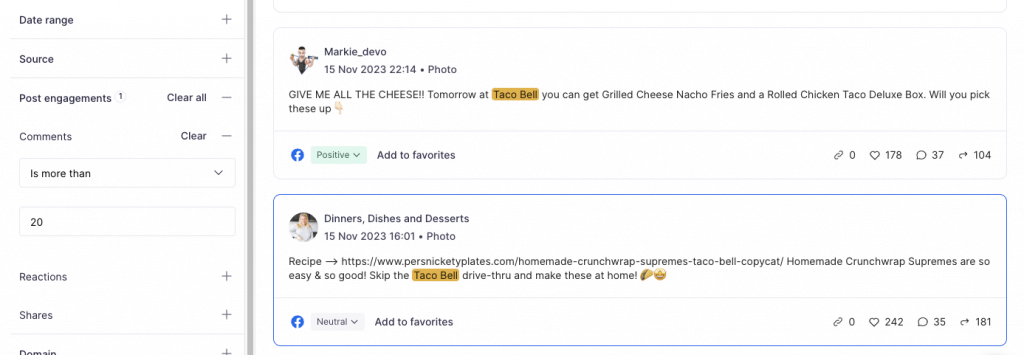
Prowly’s Social Listening tool gives a wide range of options, helpful in PR crisis prevention. It can help you understand how your audience feels about your brand. Also, you can gain insights into countries and languages where you have the highest engagement.
All of this helps you make decisions based on real data, instead of a gut feeling.
Noticing a sudden drop in sentiment and a peak in mentions’ number? That might be one of the first signs of a PR crisis on the rise.
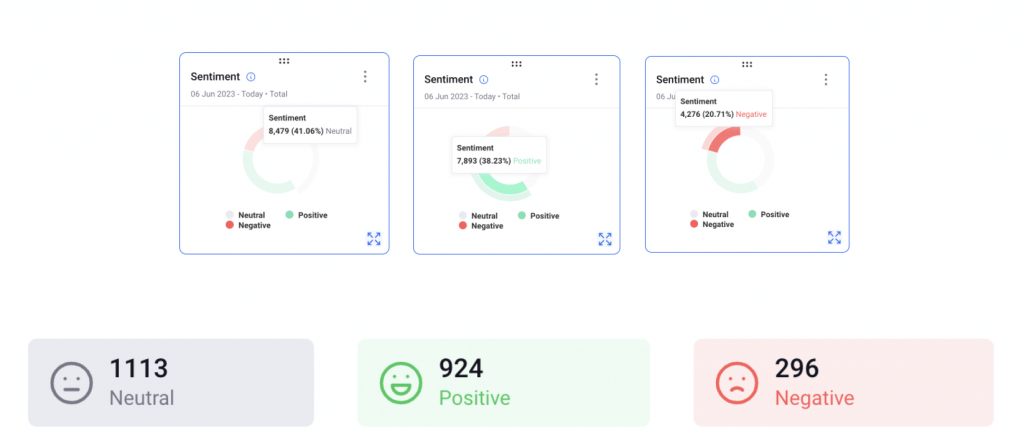
Rule #4. Pay attention to the volume of mentions
The volume of mentions will naturally rise and fall, all depending on your PR activities, marketing, and other factors. With media monitoring in place, you can set up your baseline — the normal or expected amount of chatter.
Then an unexpected rise in volume certainly won’t leave you indifferent. It can be due either to a sudden earned media success, or the alarm to man PR crisis prevention stations. Together with sentiment analysis , they can keep you informed on how to react.
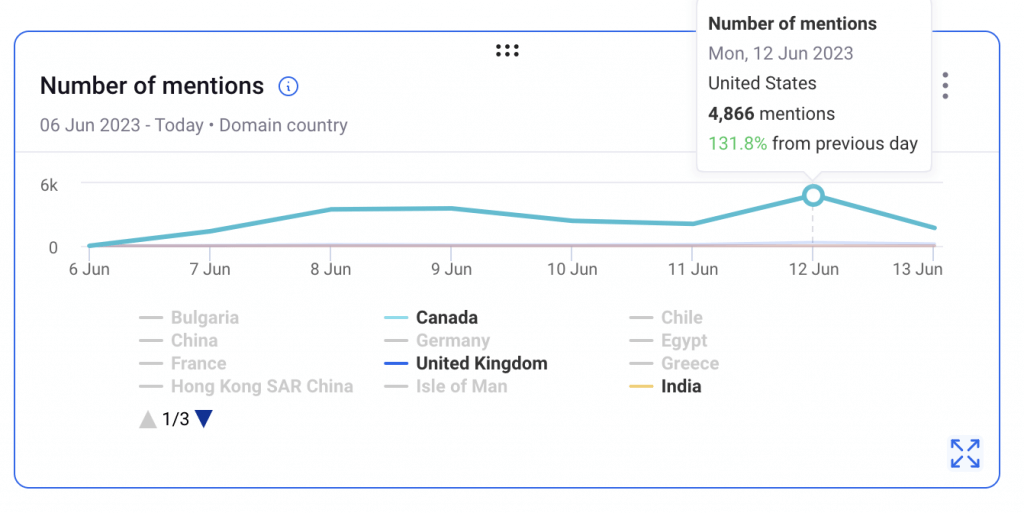
Rule #5. Use filters to focus on valuable mentions
Not all mentions bring value — especially if you track popular or generic keywords. Prowly’s tool lets you filter the results and show only what’s interesting for you. So you can save time on extracting the signal from the noise.
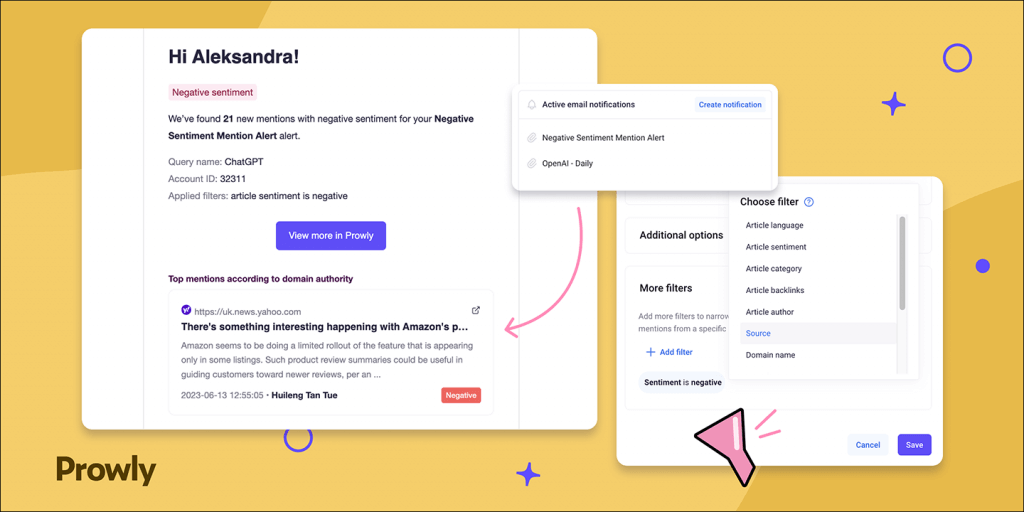
You can set various types of filters, like date range, article language, domain country, domain relevance, and sentiment. Group them together to get to the specific media mentions you need.
Rule #6. Set up alerts
Get email notifications for chosen types of mentions. You can choose what situations need your immediate attention. With alerts, you can react quicker and put out a fire before it spreads.
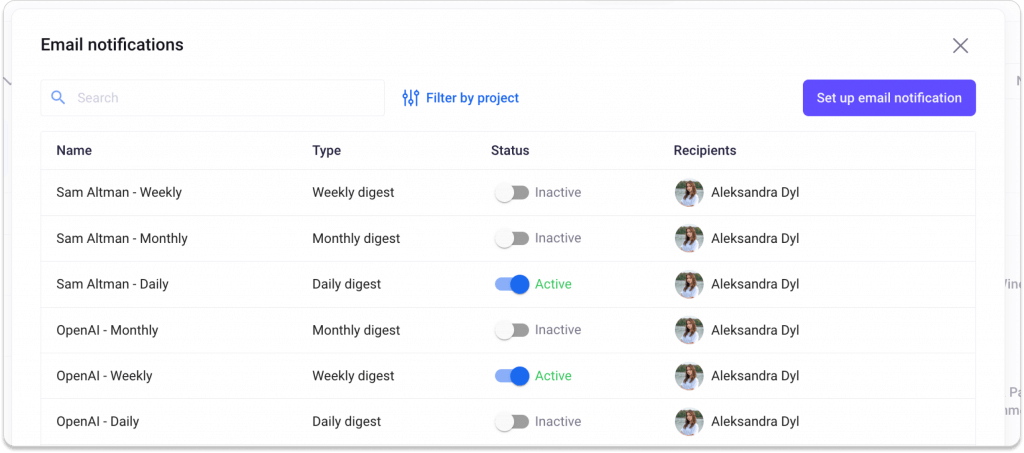
You can set up various alerts and choose who should get them. For example, your communication front line can be notified about negative sentiment mentions so that they can quickly assess a situation as it arises.
Rule #7. Create reports for crisis management
Using technology in Public Relations results in a lot of numbers. And you can use reports to showcase the impact of your work. This way, you’ll be able to better communicate the value of your work to the board.
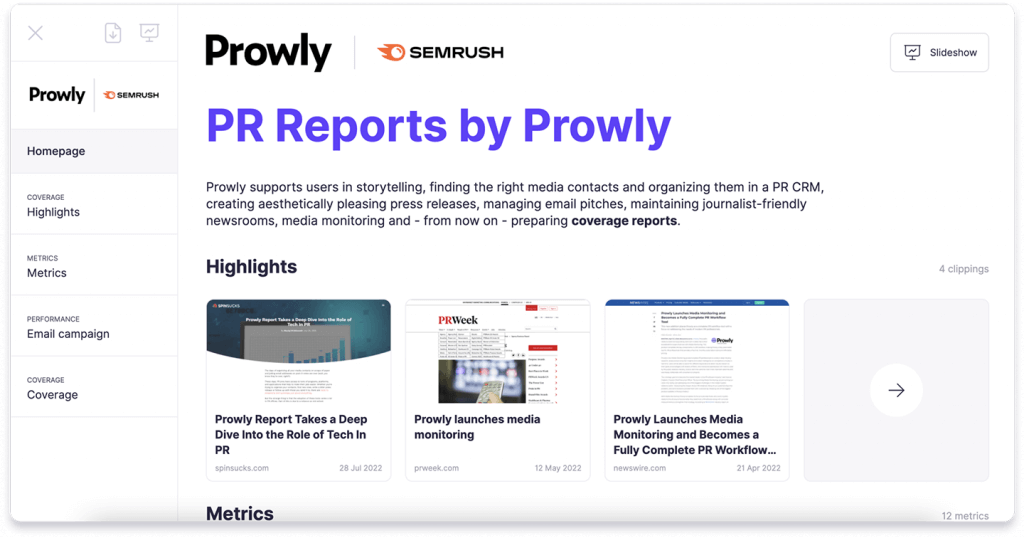
The reporting feature helps you organize mentions, show their estimated reach and views, and translate them into reliable metrics .
Showing relevant data is especially useful once you educate your stakeholders. If you need to explain to them why it is so important to have a PR specialist on board a crisis team, the numbers can help get your point across.
Insights you gather in a clear, easy-to-digest format will definitely help you prepare for an upcoming PR crisis. They are invaluable in assessing the efficiency of your strategies. With reports, you don’t have to go through each situation in detail – just the crucial information.
Rule #8. Keep an eye on your competition
You could limit your monitoring to your brand or go beyond and observe your competition.
If your competitor faces a PR crisis, you’ll be able to assess the situation and make sure it doesn’t impact your business. Also, you can analyze their reactions and draw insights for future use.
How to handle a PR crisis
It all starts with preparation. Here’s how to manage a PR crisis:
Step 1. Identify potential crisis triggers
This helps you spot potential problems sooner. If you notice a trigger, you can observe how the situation develops and adjust your response.
Potential crisis triggers can be:
- New challenges faced by your competitors or the industry in general
- A PR crisis of one of your competitors
- A negative review of your business
- Mismatched marketing communication
- An executive scandal
- Harassment or discrimination testimonials
Classify the triggers to quickly assess how serious the situation can be.
Step 2. Prepare procedures for PR crises
Adjust your plan of action to how severe the situation is, as one of the crucial rules claims: don’t overreact . Your reaction is also crucial in calming (or worsening) a PR crisis. Putting more effort into putting out a fire than is necessary gives the impression that there is something more to hide.
Come up with a few procedures to follow. They can quicken your reaction time.
Specifically, you’ll want to establish:
- Who is the first response line
- Who makes up the crisis PR strategy team
- What type of media you use to reply
- When it should be escalated
If the situation can seriously threaten your company, make sure the public relations and crisis management teams cooperate. As you’ll have to work on the unified message you send out to the public, having at least one PR specialist on board is a must.
Step 3. Craft a crisis response strategy
When a crisis hits, you don’t have much time to come up with your first words from scratch. A few versatile forms of addressing the problem should be prepared in advance. You can opt for a press release , social media posts, video statements, or blog posts.
In PR crisis management, an effective emergency response to negative publicity includes:
- Reassurance
- Transparency
- An appropriate, respectful tone
Make sure to highlight that you’re investigating the situation. Show that you care and respect your clients and stakeholders, and above all treat the issue seriously.
Your quick reaction can show you have control over the situation and gives you time for a more detailed response, and that’s gold in crisis PR management.
Later, when you know more about the situation, a press release or more advanced content forms are definitely your go-to tool. Check out our crisis press release examples and see how to craft your own.
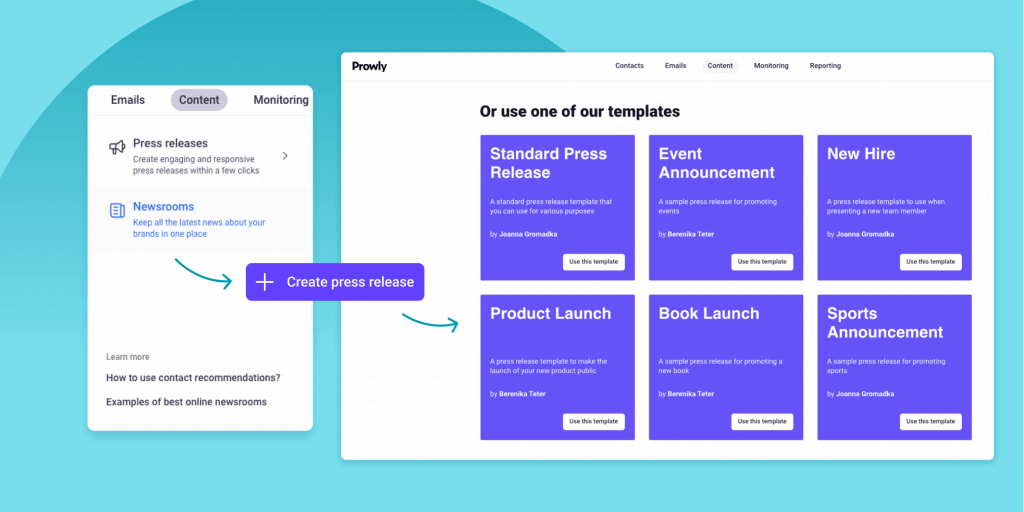
Step 4. Revise your actions after each PR crisis
Learning from real-life situations plays a huge part in PR (and crisis) management. Make sure to assess the efficiency of your PR strategies for crisis management and build them up with new insights as you gain them.
Of course, it’d be best to do it after each PR crisis you spot in your industry. Potentially, you may face similar issues as your competitors, and the audiences’ reactions can guide you in improving your messaging.
Step 5. Implement helpful technology
PR tools like Prowly help you in efficient media crisis management at all stages of a PR crisis:
- Media Monitoring helps to spot incoming crises and tracks how they develop over time.
- Media Database provides access to over 1 million contacts and helps you build targeted media lists and pitch your side of the story with a personalized message.
- Online Newsroom and Press Release Creator give you the tools to share your narrative and respond to a crisis.
- PR Reports let you analyze the numbers and assess the final impact.
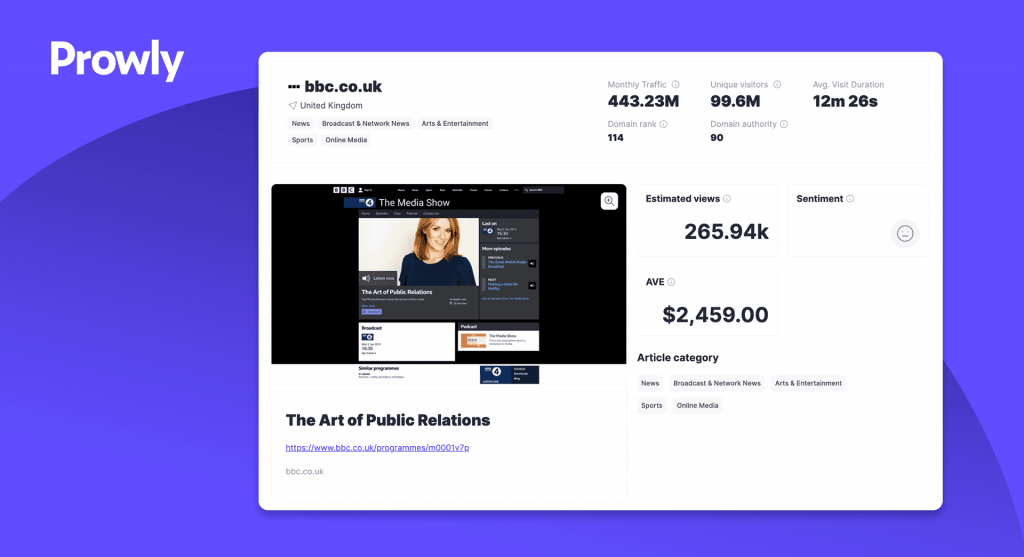
Good PR Crisis Management Examples
The best way to learn is from real-life PR crisis examples, and believe me: when it comes to this topic, it’s a never-ending story.
That’s why we’ve collected some recent PR crisis examples — both good and bad. Read our analysis and give it some thought. What would you do in such situations?
Let’s start with one of the best crisis management examples:
PR crisis management example #1. Slack
Imagine losing access to your company’s main communication tool — for 5 hours. That’s what happened to Slack users back in 2022.
The company faced the challenge with transparency, keeping their users updated. They even spoke openly about the errors they made in the process. Finally, a sincere apology (with a bit of the sense of humor well known in their overall messaging), made a perfect finish to the crisis.

Slack kept the trust of its users with transparency and honesty. They owned their errors and made sure their users were informed about their progress.
PR crisis management example #2. Aldi’s #freeCuthbert
What is an example of good crisis management? Aldi can certainly share some insights.
Back in 2021, M&S, a UK-based food store chain, called their competitor, Aldi, to court. The reason? Aldi’s caterpillar cake, Cuthbert, seemed to bear a resemblance to M&S’s version, Colin. If M&S had succeeded in court, it would have had severe consequences – and have caused a huge PR crisis.
And what was Aldi’s reaction?
Together with their agency, McCann Manchester, they held a brilliant social media campaign which aimed to win people’s hearts. It all started with a simple tweet:
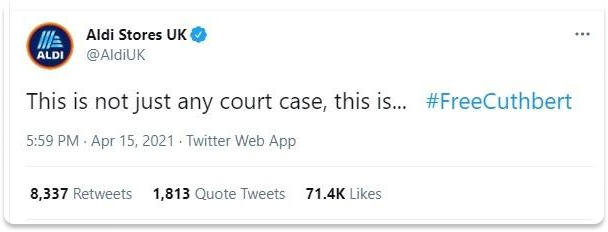
Their entire campaign consisted of about 20 posts, published on Twitter and Facebook for around a week.
And the results were impressive:

They were featured in the media (gaining around £5m in earned media), and significantly increased their followers and social engagement rate. #freeCuthbert was the most popular hashtag on Twitter… twice. People started to make memes and widely used the hashtag.

Also, the entire situation changed the news’ sentiment (Aldi +8.5%, M&S -134%), as well as purchase consideration (Aldi +6.1%, M&S -15.3%). Those are serious numbers that impacted both businesses’ bottom lines.
Aldi went further, calling all supermarkets to donate money to cancer foundations – with a new campaign, #caterpillarsForCancer. Cuthbert is still present in their marketing actions, being a big part of their company easter eggs.
The campaign not only turned the PR crisis into a massive win. It even took the Grand Prix at The Drum Award for Social Media, and another Grand Prix at Eurobest Awards in the category of “Influencers and Social.”
PR crisis management example #3. Burger King
Brands are getting increasingly more engaged in social issues, especially on dates like International Women’s Day. It can be either successful, shedding light on the cause by raising controversy, or a disaster.
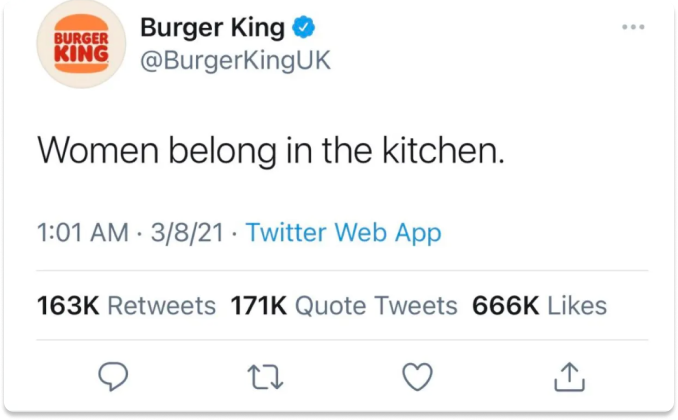
Taking a harmful statement and trying to give it a new meaning was a bold decision. In this case, Burger King made the wrong call and provoked their own PR crisis.
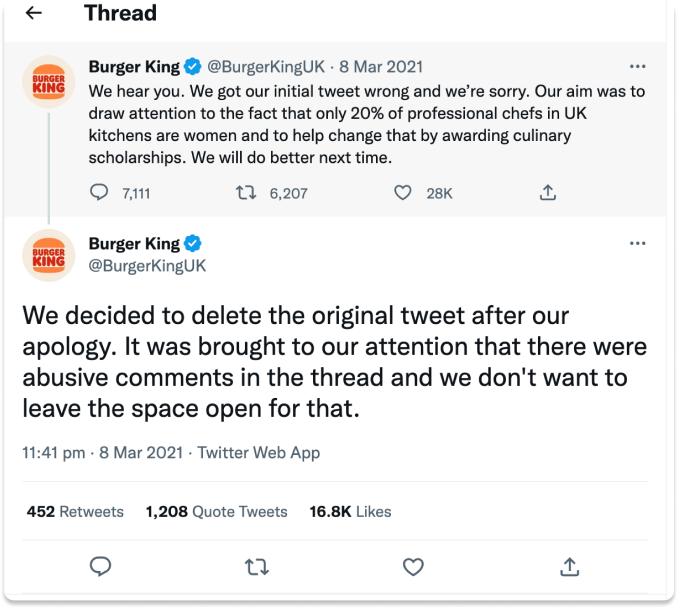
What was Burger King’s Public Relations response to the crisis? The company owned their misjudgment and sincerely apologized. Pro tip, there’s no place for “To all those who felt offended, I want to apologize.” They proceeded with showing the aim of the campaign, which was in helping women pursue their dreams of becoming professional chefs.
Also, they explained their decision to delete the original tweet. As the team claimed, comments that appeared in the following thread were abusive and they didn’t want to allow them. Without this context, it might have been seen as an attempt to clean up their image and pretend that nothing happened.
Best PR crisis management examples: a wrap-up
Let’s summarize the most important take-aways:
⬛ The golden rule is transparency and owning your mistakes . This alongside acknowledging the feelings of your audience helps maintain their trust.
⬛ Even when you’re hit by a crisis, PR communication allows some space for humor. Make sure to choose the appropriate moment, though, like Slack – they only became humorous again after solving the problem. Also, it needs to keep in line with your brand voice.
⬛ The last point is, don’t forget about giving legitimate reasons for the company’s decisions. Burger King deleting the original tweet without explanation would garner more criticism, not praise.
In the best crisis management examples you can spot a common thread of transparency. Even Aldi, with its playful campaign, didn’t run away from the fact that it was sued for their cake’s similarities.
Bad crisis management examples
Let’s go through some cases where crisis management in PR heavily and negatively impacted the company:
PR crisis management example #1. Silicon Valley Bank
This might be the first bank run fueled by social media – a media crisis example to learn from.
The SVB specialized in tech sector financing. With the boom for tech companies that arose with the pandemic, it became the 16th biggest bank in the U.S. and provided financing for about half of all U.S. venture-backed technology and healthcare companies.
Nevertheless, inflation and poor managerial decisions caused a drop in the bank’s portfolio value.
On March 8, it started to sell its bonds at a loss to gain capital. As a result, people became alarmed that their money wasn’t secure. They started withdrawing it, and a wildfire spread across Twitter and WhatsApp, inducing panic.
As a result, the next day SVB’s stock plummeted by 60% and, on March 10, it collapsed.
The relationship between the Twitter noise and the bank’s stock price decrease was confirmed on a larger scale by experts at The Conversation . Their research shows how impactful social media can be – up to the point of predicting a banks’ destabilization. And, as the SVB example shows, it can even lead to bankruptcy.
PR crisis management example #2. Twitter becoming X
What is an example of a PR crisis in 2023? Twitter , under the lead of Elon Musk, certainly had its share. But we’ll focus now on their rebranding. Twitter was renamed to X — the everything app, which would include payments, video streaming, and e-commerce.
What caused the problem?

First of all, the rush. When the rebranding was announced, the company visibly wasn’t ready for it. From a lack of changes in copy to issues with the domain name, it added up to a quickly diminishing trust.
What’s more, it was an attempt to eradicate a well-known name, which had grown into everyday language. People still tweet their tweets even now, instead of x-ing their x-es. With Twitter traces still visible in the service, the X name has a long way to go before it can ever Twitter.
Musk also (famously) used Twitter (errr, X) polls to make the final calls on rebranding, like setting the default platform color to black. As you can see on the tweet date, it was posted soon before the rebranding was announced.
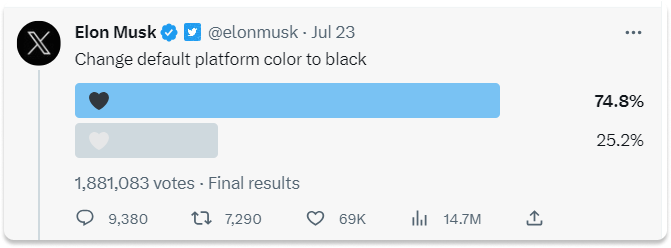
This chaotic rebranding communication is only a part of what was a somewhat dubious attempt at media crisis management. Public Relations experts shared their insights with Forbes, talking about how Musk’s actions contributed to the Twitter crisis .
PR crisis management example #3. Ticketmaster vs Swifties battle
Taylor Swift definitely has one of the biggest and most active fan bases in the world — and Ticketmaster, a ticker vendor site, faced their anger. Imagine: you’re a die-hard fan who can’t get tickets to her first tour in years.
And that’s exactly what happened.
Ticketmaster kicked off the sign-up process for their Verified Fan presale, giving Swifties the opportunity to get their tickets ahead of the crowd. Its aim was to exclude bots and smooth out the buying process.
Yet, there arose the first problem. When the presale was about to start, they randomly handed out presale codes to 1.5 million fans, leaving a whopping 2 million registered Swifties out in the cold. Nevertheless, the site was hit by over 14 million visitors.

As you can imagine, the servers couldn’t manage the load.
Even fans who got the code couldn’t buy tickets, yet at the same time, bots began to appear on the site. This proved that the Ticketmaster system was not prepared for the flood, and was still vulnerable to bots.
Finally, there weren’t enough tickets left for a public sale, which was eventually canceled. Tons of fans ended up without the possibility of buying a ticket. What’s worse? Tickets available on resale platforms reached prices of up to several thousand dollars.
Swift herself published a statement where she expressed disappointment, comparing the buying process to going through “several bear attacks.”
The issue led fans and the ticket platform to court , boosting the discussion about Ticketmaster’s monopoly. The case was even tackled (again) by the U.S. Congress .
As for Ticketmaster and their reaction, they committed various mistakes along the way.
When the problem appeared, they didn’t opt for proactive communication, leaving most of the fans uncertain. They also didn’t comment on any actions they would take to alleviate the problem.

Their tweet about canceling the tour sale lacked any form of acknowledging their fault, pushing it on “extraordinarily high demands.” As Swift stated, she and her team insisted on ensuring that the service would meet the spike, which is contradictory to Ticketmaster’s own words.
Later, they re-published a previously deleted statement with slight edits and added an apology. The first version worsened the audience’s reaction and finally got taken down from the company’s website.
A lack of transparency and accountability fueled the development of the PR crisis it had to face.
Worst crisis management examples: a wrap-up
Let’s sum up these PR disasters with three takeaways.
⬛ The major mistake is chaotic communication – or its lack. In difficult times, each word is assessed by everyone involved. Your choice (even to remain silent) weighs heavily on how a crisis evolves.
⬛ Furthermore, a lack of ownership which contradicts the basic PR rules of an effective apology. These classic rules can guide you on how to approach common situations. Finally, they help get you out of a brand reputation crisis .
In all of the above examples, we have to acknowledge the impact of social media. It seems obvious and well-worn already, but the consequences we saw in 2023 – as serious as taking down a bank – have to be respected.
Key takeaways: effective PR crisis management
PR teams have an increasingly more challenging task. Firstly, companies (and their leaders) are sending out more communication all the time, so the chance of missing the mark continues to rise. At the same time, anyone can reply and start a fire. In this environment, the way you handle it can make or break (or at least damage) your company.
Remember the stages of crisis management in public relations: preparation, damage assessment, take action, and analysis.
The most important part of managing any PR crisis is preparation. Think about the problems you could face and plan ahead with possible solutions. They can prove invaluable when time literally becomes money.
Proper technology helps you face any PR crisis more effectively. Prowly proves useful not only in times of PR crisis, it covers your entire PR workflow: with media pitching , an online newsroom , and press release creator .
Sounds interesting? Give it a try for 7 days for free.
Related articles
What are brand mentions and how to track & analyze them, how to measure brand sentiment in pr – the 2024 guide, how to write a crisis press release (examples and templates).

Download Free Press Release Templates
(in Microsoft Word & .pdf Format)
- Prowly PR Software
- Find journalists
- Media database
- Create press releases
- Press release creator
- Pitch the media
- Media pitching software
- Manage media contacts
- Publish press releases
- Online newsroom
- Book a demo
- Prowly Academy
- Testimonials
- Prowly Journal
- Partner Program
- Brand Newsroom Examples
- Press Release Examples
Public Relations Campaign Advertising Case Study
Campaign overview, objectives:.
Increase Brand Awareness: Position [Your Company Name] as a frontrunner in eco-friendly solutions.
Engage Target Audience: Build a community of environmentally conscious consumers and businesses.
Promote New Product Line: Introduce and market [Your Company Name]'s innovative range of biodegradable products.
Educate Public: Raise awareness about sustainable living practices.
Campaign Strategy Key Messages Development
Sustainability as a Standard
Approach: Develop a narrative around [Your Company Name]'s commitment to sustainable practices, showcasing their involvement in eco-friendly initiatives and sustainable product development.
Tactics: Feature stories and case studies on the company blog, press releases highlighting sustainability milestones, and social media content focused on [Your Company Name]'s green initiatives.
Innovative Green Products
Approach: Position [Your Company Name]'s products as not only eco-friendly but also innovative and superior to conventional alternatives.
Tactics: Create detailed product feature videos, interactive web content showcasing the benefits and USPs (Unique Selling Propositions), and user-generated content campaigns encouraging customers to share their experiences.
Community and Global Impact
Approach: Illustrate [Your Company Name]’s role in creating a positive environmental impact both locally and globally.
Tactics: Partner with local and international environmental organizations for joint campaigns, document and share community events and global initiatives through multimedia content.
Educational Outreach
Approach: Educate the public about the importance of sustainability and how they can contribute.
Tactics: Develop an educational blog series, create downloadable resources and guides, and conduct workshops and webinars.
Target Audience Segmentation
Multi-channel approach.
Social Media Strategy
Platforms: Facebook, Instagram, LinkedIn
Content Mix: Educational posts, behind-the-scenes at [Your Company Name], product highlights, influencer collaborations.
Engagement Plan: Regular interactive posts (polls, Q&As), live sessions, and story updates.
Print and Online Media
Type: Eco-magazines, local newspapers, environmental blogs.
Content: Feature articles, press releases, guest blog posts.
Goal: Increase brand visibility and educate the public on [Your Company Name]'s initiatives.
Events and Workshops
Types: Community planting events, eco-conferences, educational workshops.
Engagement: Interactive activities, hands-on learning experiences, networking opportunities.
Promotion: Pre-event social media buzz, live coverage, post-event highlights.
Educational Collaborations
Programs: Sustainability workshops, educational materials for schools, student engagement activities
Goals: Educate the younger generation, create brand ambassadors, foster long-term environmental awareness
Measurement and KPIs
Campaign execution, key activities:.
Robust Social Media Campaign: Leveraging influencers, creating engaging content, and running targeted ad campaigns.
Comprehensive Website Launch: Introducing an interactive, informative section dedicated to "[Campaign Name] with a blog, detailed product information, and sustainable living tips.
Regular Press Releases: Monthly press releases to a wide range of eco-magazines, news websites, and industry publications.
Community and Educational Events: Hosting tree planting events,sustainable living workshops, and participating in eco-conferences.
Partnerships with Schools: Implementing educational programs in schools to teach children about sustainability.
Budget Breakdown
Results and impact, achievements:.
Social Media Metrics: Over 3 million impressions, with significant engagement in shares and comments.
Website Performance: 60% increase in traffic, high interaction with the "[Campaign Name]" blog.
Event Success: Over 7,000 participants in various events, with positive feedback and media coverage.
Educational Impact: Reached over 50 schools and impacted around 10,000 students through the educational program.
Overall Impact:
Brand Visibility: 50% increase in brand recognition among the target audience.
Sales Growth: 30% increase in sales of the new biodegradable product line.
Environmental Contribution: Contributed to planting over 15,000 trees and educated communities on sustainability.
Media Reach: Featured in 30+ environmental publications and news outlets.
The "[Campaign Name]" campaign was a resounding success, exceeding its objectives and establishing [Your Company Name] as a prominent name in the sustainable solutions sector. The campaign's multi-faceted approach, combining digital outreach, real-world events, and educational initiatives, resonated deeply with the target audience, resulting in increased brand awareness, sales, and a significant positive environmental impact. The campaign not only promoted [Your Company Name]'s products but also fostered a broader conversation about sustainability, positioning the company as a thought leader in the field.
Advertising Templates @ Template.net

- Free Case Studies
- Business Essays
Write My Case Study
Buy Case Study
Case Study Help
- Case Study For Sale
- Case Study Service
- Hire Writer
Functions of Public Relations
Although this is useful – it contains many key concepts – and saves us plugging through hundreds of definitions, it describes what PR does rather than what it is. Or, indeed, should be. described the attempts to define public relations as largely “constructed in an attempt to be all things to all people simultaneously”. The words “art” and “social science” are helpful in explaining the continuing tension between understanding PR as a measurable, science-based application of communication tools and the affection of many practitioners for the looser, more creative, aspects of the work. In the USA the social science elements dominate the understanding of PR, as is reflected in their education and texts about the subject. In the UK, there has been a tension between those who see public relations as a management function and those who view it primarily in relation to the media.
Originally most PR degrees were taught in business schools. However, unpublished research by the author for the Institute of Public Relations (IPR) (2003) suggests an increase in degrees based in schools of media and journalism.(Lerlo, pp.23) Media monitoring seems to be one of most widely used tracking methods for public relations departments, but again it lacks validity in terms of what you really need to accomplish in terms of your relationships – with one possible exception. If you are working toward enhancing your organization’s reputation with the media, you might be concerned that they begin to actually use your material. Keep in mind, however, that extrapolating to how many members of other publics saw and understood your message is dangerously lacking in substance.
We Will Write a Custom Case Study Specifically For You For Only $13.90/page!
But there are also other reasons for doing media monitoring on a regular basis. In considering media relations, the objectives would be directed specifically toward the media. These objectives about what the public relations planning process aims to achieve are related to what the organization aims to achieve in community relations, employee relations, investor relations, relations with activist organizations, and so on. Keying objectives to specific publics enables a more directed selection of communication strategies later. (Barnett, pp.
15) Although you might select a particular strategy or vehicle that can achieve more than one objectives and is directed toward more than one public, you will eventually need to examine the outcomes for each public separately. Marketing PR was initially claimed by many manager to be effective in at least seven areas. These included successes in: new product introduction; promoting mature products and repositioning (i.e. USA peanut marketing); winning consumer trust (banks in USA); celebrating special occasions (i.e.
Barbie, Disney characters); sponsoring public services programs (New York and other city campaigns); sponsoring good causes (i.e. pressure groups in USA); sponsoring sports activities (waste management clean ups). (Cowlett, pp.
34) In all cases, then, the outcomes were massive publicity, increased sales, increased brand awareness, brand visibility, positive feedback, and public participation. All these are positive outcomes for marketing and PR. Put another way, as early as 1993, public relations was being used for ostensible marketing purposes and was shown to have something significant to contribute. Note that in many of the successes, the outcomes would have been far more difficult to achieve (perhaps impossible) if the businesses or organizations concerned had just decided to rely on the traditional tools of marketing communication such as advertising, sales promotion, direct marketing, or personal selling. By 2001, any manager’s range of PR usage and benefits for marketing purposes had expanded markedly. …
Related posts:
- Definition of Public Relations
- Public Relations and Its Interrelation with Advertisement
- Social Media and Public Relations
- Propaganda and the Public Relations Industry
- Research Article Critique and Research Proposal in the Public Relations Issues
- What are the Main Functions of a Bank
- Functions of the Law
Quick Links
Privacy Policy
Terms and Conditions
Testimonials
Our Services
Case Study Writing Service
Case Studies For Sale
Our Company
Welcome to the world of case studies that can bring you high grades! Here, at ACaseStudy.com, we deliver professionally written papers, and the best grades for you from your professors are guaranteed!
[email protected] 804-506-0782 350 5th Ave, New York, NY 10118, USA
Acasestudy.com © 2007-2019 All rights reserved.

Hi! I'm Anna
Would you like to get a custom case study? How about receiving a customized one?
Haven't Found The Case Study You Want?
For Only $13.90/page

IMAGES
VIDEO
COMMENTS
Structure the PR Case Study for Clarity and Engagement. Craft a structured narrative that captivates your audience from start to finish. Provide a brief overview of the client and their market context before delving into the specifics of the project. Break down the case study into manageable sections such as the challenge, strategy, execution ...
2.2 Experiment with unconventional formats. 2.3 Add context to the case study. 2.4 Stay authentic and honest. 2.5 Include original imagery and graphics. 2.6 Demonstrate PR impact with tangible benefits. 2.7 Celebrate PR success. 3 Closing Thoughts on Developing PR Campaign Case Studies.
needed to prepare a fair and appropriate public relations case study. Often the principals involved do not wish to discuss details of the situation for legal and other reasons. During late June and early July l998, outstanding faculty members from leading, accredited public relations programs in the United States were invited to conduct "how to"
Identify an accomplishment you'd like to highlight, whether your own or someone else's (like a friend or client's) Download the free Case Study Template on this page. Follow the instructions in the template and fill in the blanks, adding plenty of detail. Paste the template into the content editor of your website, format it and add images.
Case study examples. While templates are helpful, seeing a case study in action can also be a great way to learn. Here are some examples of how Adobe customers have experienced success. Juniper Networks. One example is the Adobe and Juniper Networks case study, which puts the reader in the customer's shoes.
Client touchpoints: Your case study should amplify the client-focused nature of your PR work and reinforce your ability to deliver exceptional results. Calling out client communications throughout your campaign is a great way to do that. By explicitly mentioning meetings, consultations, and communications, you emphasize your PR services ...
By the end of the semester - through numerous PR case studies from the textbook and "in the news," and two major case analyses - you will be equipped to: Fully understand the public relations process. Critique different approaches to PR research, strategy, execution and evaluation. Consider public relations theories, communication ...
Homebase is an all-in-one SMB team management platform that serves over 100,000 small businesses and two million hourly workers to […] 1 2 3. Looking for PR Case Studies? This resource offers both experience and insight into the business of public relations, and can help guide your agency.
The case study is a descriptive, qualitative research method that analyzes in great detail a person, an organization, or an event. Case studies are found in most applied areas, such as business, law, and marketing, and offer insight into practices and tactics. The case study's major advantage is the detail and analysis it provides of a specific ...
The case studies explore PR dilemmas and campaigns in a variety of sectors and circumstances. The book offers learning opportunities about audience analysis, campaign planning, strategy, tactics, message development, media relations, and crisis communications for the PR practitioners of today and the future. This book is available free of ...
The authors of this study followed the Hendrix Process Model of public relations case study analysis, which applies the mnemonic "ROPE" as a template to evaluate a PR initiative and structure a critique. ROPE consists of four phases. The first element is research, which explores the client, the problem or issue to be solved, andthe audience ...
This page contains a library of public relations templates to help you get more coverage from journalists and bloggers. Free step-by-step PR plan template to help you land media coverage. No email sign-up required. Free press release template to help you get coverage in the media and in industry blogs. Fill-in-the-blanks journalist pitch ...
Public Relations Case Study. PR for Anyone. MAY 5, 2020. In this week's episode, Christina Daves talks about a public relations case study during COVID-19. Part One of 'Public Relations Case Study ' Christina has gained billions of views from free publicity and over a hundred million in sales.
ISBN: 9781506349152. Publication Date: 2018-09-06. Cases in Public Relations Strategy draws on original, real-world case studies to provide students with a strategic approach to meeting the needs of a client before, during, and beyond a campaign. Last Updated: May 18, 2024 10:16 AM.
These resources and templates may be helpful as you undertake a public relations campaign at a future date. We will refer back to this primer elsewhere in the course for specific examples supporting subunit topics ahead. For now, it gives a useful overview of the public relations craft and some tools at its disposal.
Download this Public Relations Campaign Advertising Case Study Template Design in Word, Google Docs, PDF Format. Easily Editable, Printable, Downloadable. Showcase your PR success with Template.net's Public Relations Campaign Advertising Case Study Template.
3. Lego Rebuild the World. Their first global PR campaign in decades, Lego's Rebuild the World was focused on inspiring creative thinking in kids—but also adults. As part of the public relations campaign, Lego asked customers to submit pictures of their creations, aggregated onto a 3D globe on the brand's website.
Cases in Public Relations Strategy draws on original, real-world case studies to provide students with a strategic approach to meeting the needs of a client before, during, and beyond a campaign. Using the RACE (Research, Action Planning, Communication, and Evaluation) model, students explore successful contemporary campaigns and evaluate best practices in all major areas of public relations ...
These are: 1. Create a great executive summary. The first section of your proposal should be a concise summary outlining the key elements of your campaign suggestion. This element will "hook" your prospect, so be sure to include a visually attractive cover and a compelling look at your plan.
PR crisis management is an organizational strategy to manage and mitigate unexpected events that pose a threat to the reputation or survival of a company. This approach focuses on thorough planning to promptly and efficiently respond to any crisis that could impact the company's image or stakeholder relationships.
Our templates provide a foundation for effective PR strategies. Collaborate effortlessly with your team, tailor the templates to match your brand messaging, and effectively communicate your key messages to the public, media, and stakeholders using Xtensio's collaborative workspace. Pick a template. Customize everything, together. Deliver ...
Multi-Channel Approach. Social Media Strategy. Platforms: Facebook, Instagram, LinkedIn Content Mix: Educational posts, behind-the-scenes at [Your Company Name], product highlights, influencer collaborations. Engagement Plan: Regular interactive posts (polls, Q&As), live sessions, and story updates. Print and Online Media. Type: Eco-magazines, local newspapers, environmental blogs.
34) In all cases, then, the outcomes were massive publicity, increased sales, increased brand awareness, brand visibility, positive feedback, and public participation. All these are positive outcomes for marketing and PR. Put another way, as early as 1993, public relations was being used for ostensible marketing purposes and was shown to have ...